HLTENN008 Workbook: Ethical Principles, Legal Acts & Nursing Standards
VerifiedAdded on 2023/06/13
|27
|6877
|190
Practical Assignment
AI Summary
This HLTENN008 assignment provides a comprehensive overview of key aspects of nursing practice, focusing on ethical principles, legal obligations, and professional standards. It begins by defining and illustrating the ethical principles of beneficence, non-maleficence, veracity, and autonomy with practical nursing examples. The assignment identifies the Nursing and Midwifery Board of Australia's role in setting standards and guidelines, as well as the Australian Health Practitioner Regulation Agency's (AHPRA) functions in protecting the public and regulating health practitioners. It further outlines the seven healthcare rights of Australians and provides examples of how nurses can ensure these rights are met. Finally, it analyzes a nursing tribunal case using the ICN code of ethics, nursing code of conduct, and enrolled nurse standards of practice to identify breaches of ethical and professional conduct. This resource is designed to help nursing students understand and apply ethical and legal frameworks in their practice.
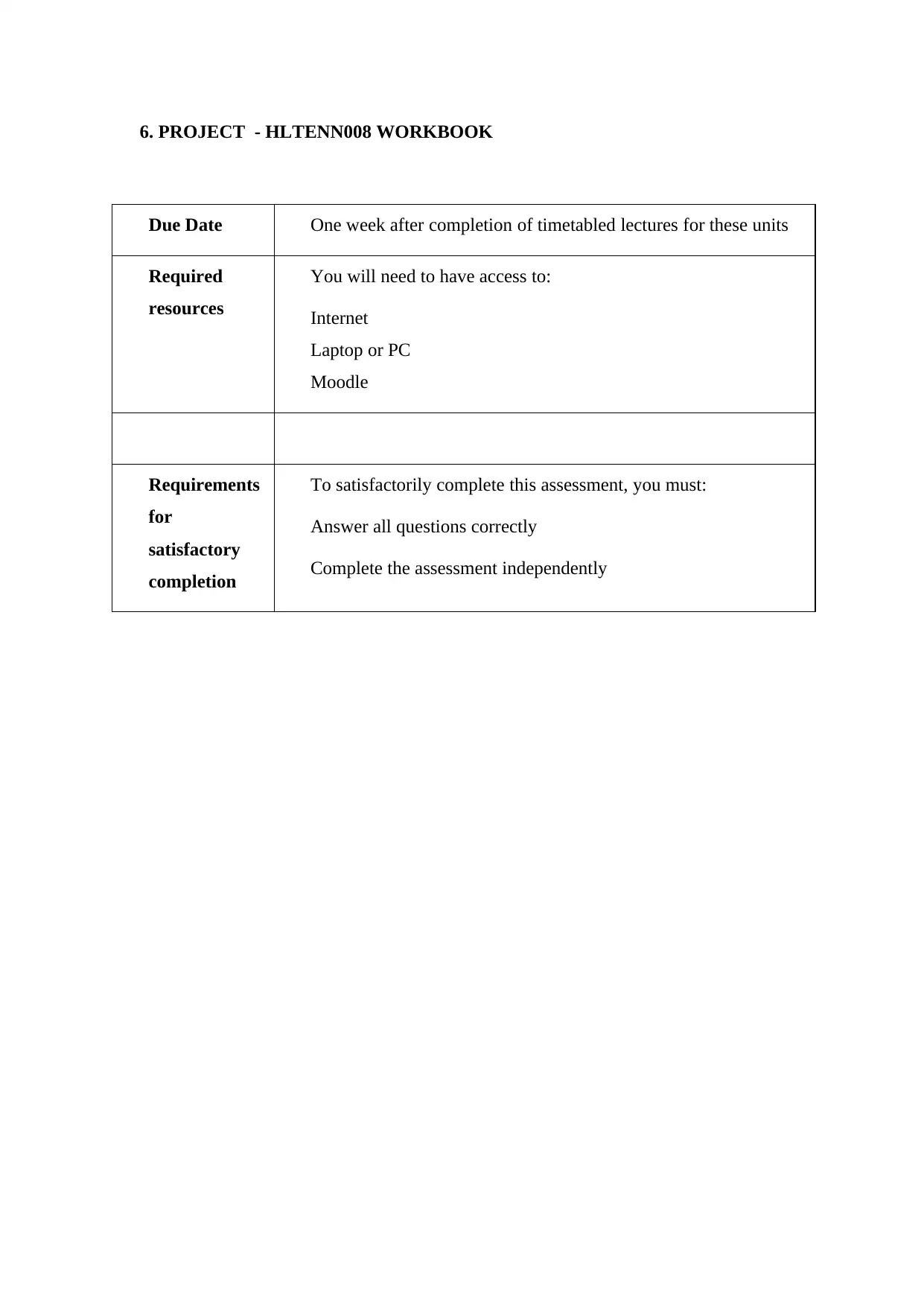
6. PROJECT - HLTENN008 WORKBOOK
Due Date One week after completion of timetabled lectures for these units
Required
resources
You will need to have access to:
Internet
Laptop or PC
Moodle
Requirements
for
satisfactory
completion
To satisfactorily complete this assessment, you must:
Answer all questions correctly
Complete the assessment independently
Due Date One week after completion of timetabled lectures for these units
Required
resources
You will need to have access to:
Internet
Laptop or PC
Moodle
Requirements
for
satisfactory
completion
To satisfactorily complete this assessment, you must:
Answer all questions correctly
Complete the assessment independently
Secure Best Marks with AI Grader
Need help grading? Try our AI Grader for instant feedback on your assignments.
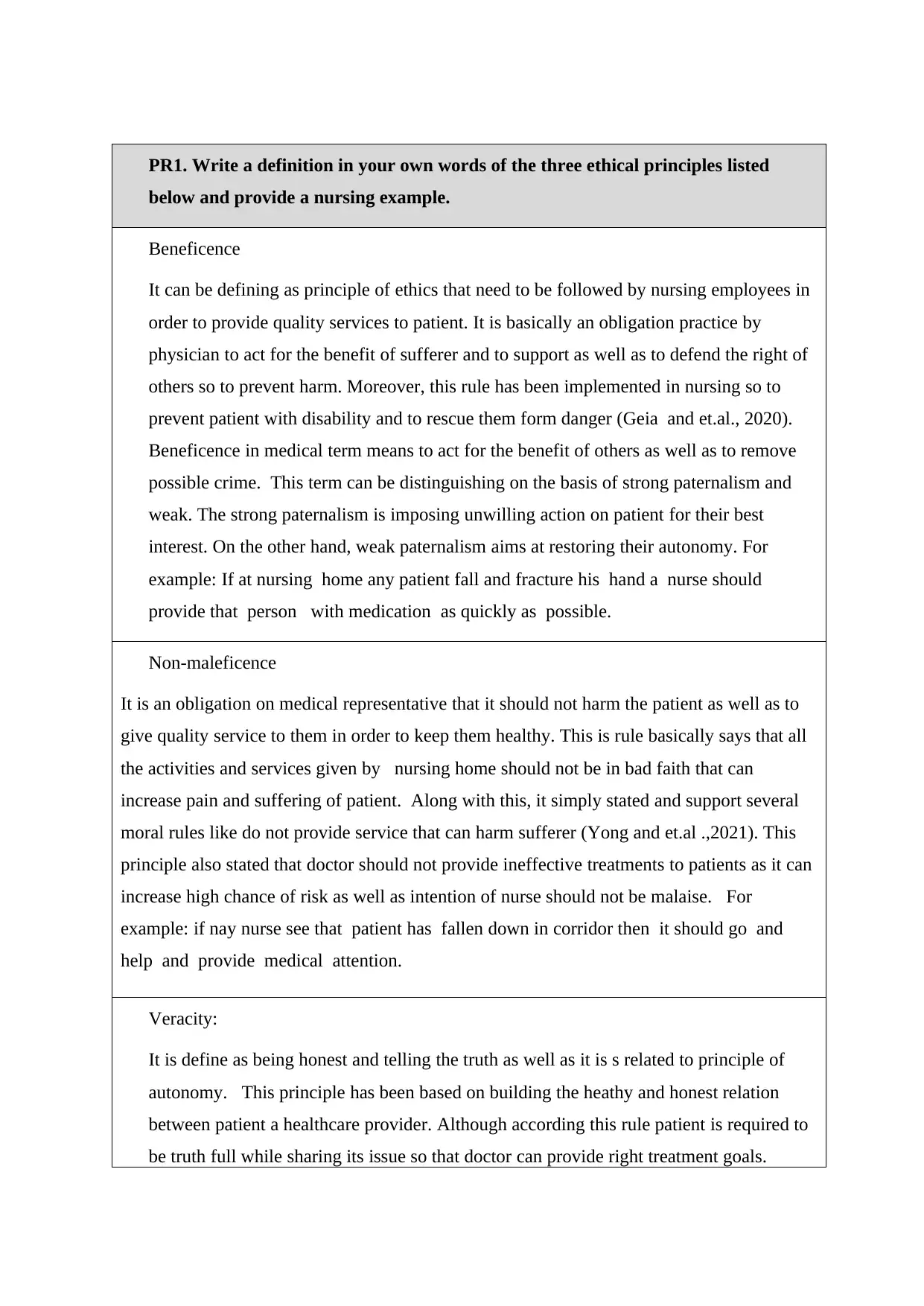
PR1. Write a definition in your own words of the three ethical principles listed
below and provide a nursing example.
Beneficence
It can be defining as principle of ethics that need to be followed by nursing employees in
order to provide quality services to patient. It is basically an obligation practice by
physician to act for the benefit of sufferer and to support as well as to defend the right of
others so to prevent harm. Moreover, this rule has been implemented in nursing so to
prevent patient with disability and to rescue them form danger (Geia and et.al., 2020).
Beneficence in medical term means to act for the benefit of others as well as to remove
possible crime. This term can be distinguishing on the basis of strong paternalism and
weak. The strong paternalism is imposing unwilling action on patient for their best
interest. On the other hand, weak paternalism aims at restoring their autonomy. For
example: If at nursing home any patient fall and fracture his hand a nurse should
provide that person with medication as quickly as possible.
Non-maleficence
It is an obligation on medical representative that it should not harm the patient as well as to
give quality service to them in order to keep them healthy. This is rule basically says that all
the activities and services given by nursing home should not be in bad faith that can
increase pain and suffering of patient. Along with this, it simply stated and support several
moral rules like do not provide service that can harm sufferer (Yong and et.al .,2021). This
principle also stated that doctor should not provide ineffective treatments to patients as it can
increase high chance of risk as well as intention of nurse should not be malaise. For
example: if nay nurse see that patient has fallen down in corridor then it should go and
help and provide medical attention.
Veracity:
It is define as being honest and telling the truth as well as it is s related to principle of
autonomy. This principle has been based on building the heathy and honest relation
between patient a healthcare provider. Although according this rule patient is required to
be truth full while sharing its issue so that doctor can provide right treatment goals.
below and provide a nursing example.
Beneficence
It can be defining as principle of ethics that need to be followed by nursing employees in
order to provide quality services to patient. It is basically an obligation practice by
physician to act for the benefit of sufferer and to support as well as to defend the right of
others so to prevent harm. Moreover, this rule has been implemented in nursing so to
prevent patient with disability and to rescue them form danger (Geia and et.al., 2020).
Beneficence in medical term means to act for the benefit of others as well as to remove
possible crime. This term can be distinguishing on the basis of strong paternalism and
weak. The strong paternalism is imposing unwilling action on patient for their best
interest. On the other hand, weak paternalism aims at restoring their autonomy. For
example: If at nursing home any patient fall and fracture his hand a nurse should
provide that person with medication as quickly as possible.
Non-maleficence
It is an obligation on medical representative that it should not harm the patient as well as to
give quality service to them in order to keep them healthy. This is rule basically says that all
the activities and services given by nursing home should not be in bad faith that can
increase pain and suffering of patient. Along with this, it simply stated and support several
moral rules like do not provide service that can harm sufferer (Yong and et.al .,2021). This
principle also stated that doctor should not provide ineffective treatments to patients as it can
increase high chance of risk as well as intention of nurse should not be malaise. For
example: if nay nurse see that patient has fallen down in corridor then it should go and
help and provide medical attention.
Veracity:
It is define as being honest and telling the truth as well as it is s related to principle of
autonomy. This principle has been based on building the heathy and honest relation
between patient a healthcare provider. Although according this rule patient is required to
be truth full while sharing its issue so that doctor can provide right treatment goals.
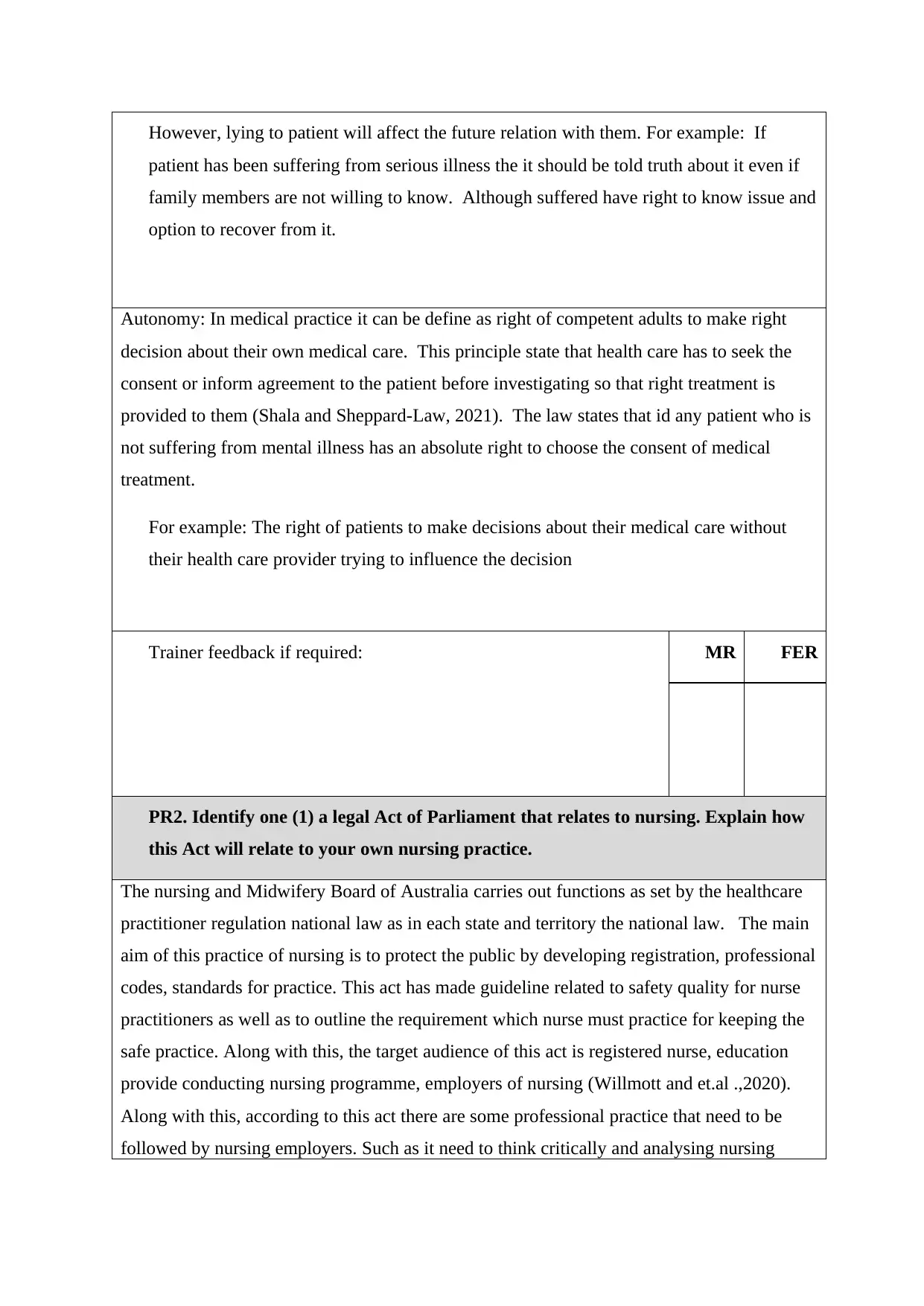
However, lying to patient will affect the future relation with them. For example: If
patient has been suffering from serious illness the it should be told truth about it even if
family members are not willing to know. Although suffered have right to know issue and
option to recover from it.
Autonomy: In medical practice it can be define as right of competent adults to make right
decision about their own medical care. This principle state that health care has to seek the
consent or inform agreement to the patient before investigating so that right treatment is
provided to them (Shala and Sheppard-Law, 2021). The law states that id any patient who is
not suffering from mental illness has an absolute right to choose the consent of medical
treatment.
For example: The right of patients to make decisions about their medical care without
their health care provider trying to influence the decision
Trainer feedback if required: MR FER
PR2. Identify one (1) a legal Act of Parliament that relates to nursing. Explain how
this Act will relate to your own nursing practice.
The nursing and Midwifery Board of Australia carries out functions as set by the healthcare
practitioner regulation national law as in each state and territory the national law. The main
aim of this practice of nursing is to protect the public by developing registration, professional
codes, standards for practice. This act has made guideline related to safety quality for nurse
practitioners as well as to outline the requirement which nurse must practice for keeping the
safe practice. Along with this, the target audience of this act is registered nurse, education
provide conducting nursing programme, employers of nursing (Willmott and et.al .,2020).
Along with this, according to this act there are some professional practice that need to be
followed by nursing employers. Such as it need to think critically and analysing nursing
patient has been suffering from serious illness the it should be told truth about it even if
family members are not willing to know. Although suffered have right to know issue and
option to recover from it.
Autonomy: In medical practice it can be define as right of competent adults to make right
decision about their own medical care. This principle state that health care has to seek the
consent or inform agreement to the patient before investigating so that right treatment is
provided to them (Shala and Sheppard-Law, 2021). The law states that id any patient who is
not suffering from mental illness has an absolute right to choose the consent of medical
treatment.
For example: The right of patients to make decisions about their medical care without
their health care provider trying to influence the decision
Trainer feedback if required: MR FER
PR2. Identify one (1) a legal Act of Parliament that relates to nursing. Explain how
this Act will relate to your own nursing practice.
The nursing and Midwifery Board of Australia carries out functions as set by the healthcare
practitioner regulation national law as in each state and territory the national law. The main
aim of this practice of nursing is to protect the public by developing registration, professional
codes, standards for practice. This act has made guideline related to safety quality for nurse
practitioners as well as to outline the requirement which nurse must practice for keeping the
safe practice. Along with this, the target audience of this act is registered nurse, education
provide conducting nursing programme, employers of nursing (Willmott and et.al .,2020).
Along with this, according to this act there are some professional practice that need to be
followed by nursing employers. Such as it need to think critically and analysing nursing
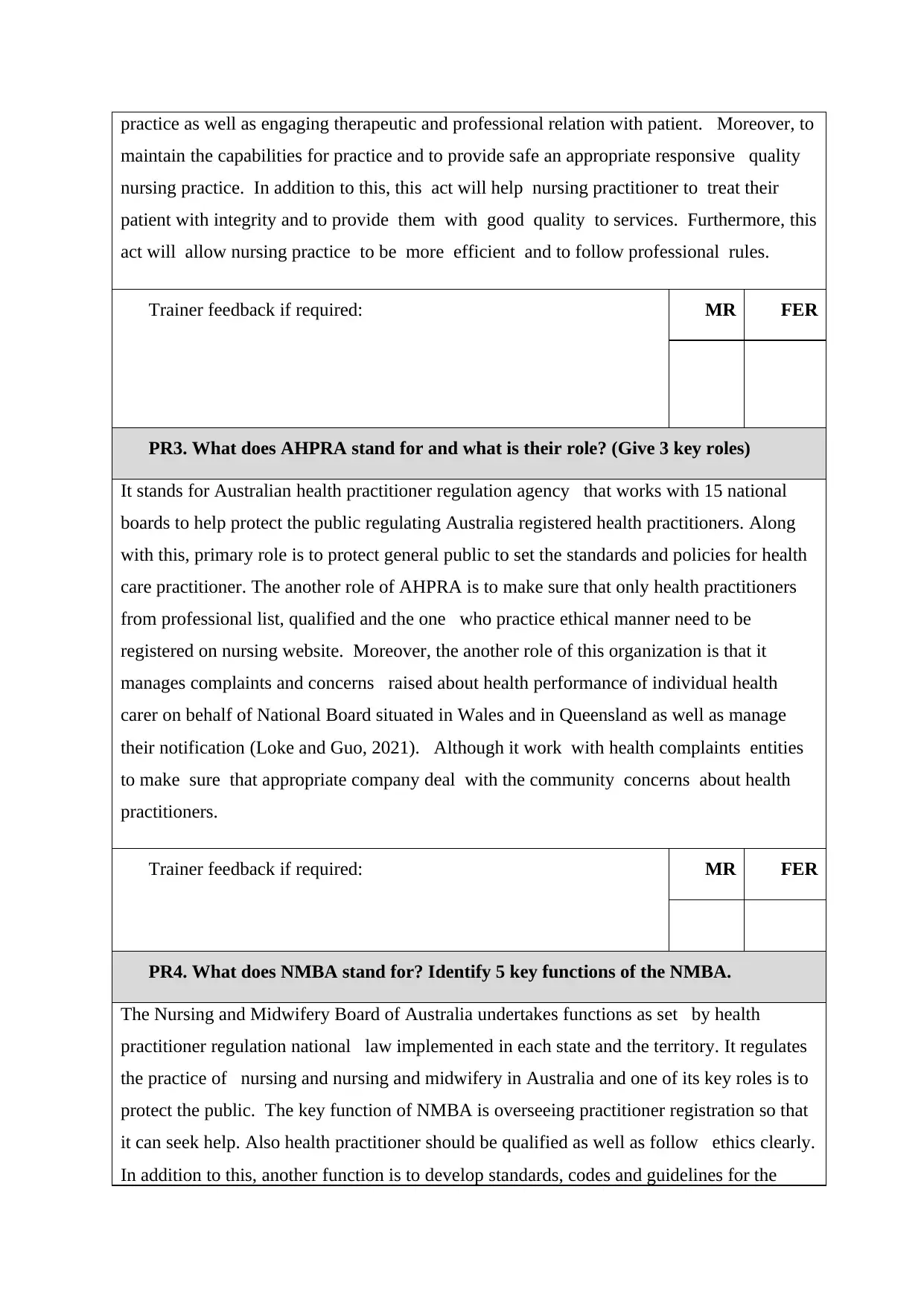
practice as well as engaging therapeutic and professional relation with patient. Moreover, to
maintain the capabilities for practice and to provide safe an appropriate responsive quality
nursing practice. In addition to this, this act will help nursing practitioner to treat their
patient with integrity and to provide them with good quality to services. Furthermore, this
act will allow nursing practice to be more efficient and to follow professional rules.
Trainer feedback if required: MR FER
PR3. What does AHPRA stand for and what is their role? (Give 3 key roles)
It stands for Australian health practitioner regulation agency that works with 15 national
boards to help protect the public regulating Australia registered health practitioners. Along
with this, primary role is to protect general public to set the standards and policies for health
care practitioner. The another role of AHPRA is to make sure that only health practitioners
from professional list, qualified and the one who practice ethical manner need to be
registered on nursing website. Moreover, the another role of this organization is that it
manages complaints and concerns raised about health performance of individual health
carer on behalf of National Board situated in Wales and in Queensland as well as manage
their notification (Loke and Guo, 2021). Although it work with health complaints entities
to make sure that appropriate company deal with the community concerns about health
practitioners.
Trainer feedback if required: MR FER
PR4. What does NMBA stand for? Identify 5 key functions of the NMBA.
The Nursing and Midwifery Board of Australia undertakes functions as set by health
practitioner regulation national law implemented in each state and the territory. It regulates
the practice of nursing and nursing and midwifery in Australia and one of its key roles is to
protect the public. The key function of NMBA is overseeing practitioner registration so that
it can seek help. Also health practitioner should be qualified as well as follow ethics clearly.
In addition to this, another function is to develop standards, codes and guidelines for the
maintain the capabilities for practice and to provide safe an appropriate responsive quality
nursing practice. In addition to this, this act will help nursing practitioner to treat their
patient with integrity and to provide them with good quality to services. Furthermore, this
act will allow nursing practice to be more efficient and to follow professional rules.
Trainer feedback if required: MR FER
PR3. What does AHPRA stand for and what is their role? (Give 3 key roles)
It stands for Australian health practitioner regulation agency that works with 15 national
boards to help protect the public regulating Australia registered health practitioners. Along
with this, primary role is to protect general public to set the standards and policies for health
care practitioner. The another role of AHPRA is to make sure that only health practitioners
from professional list, qualified and the one who practice ethical manner need to be
registered on nursing website. Moreover, the another role of this organization is that it
manages complaints and concerns raised about health performance of individual health
carer on behalf of National Board situated in Wales and in Queensland as well as manage
their notification (Loke and Guo, 2021). Although it work with health complaints entities
to make sure that appropriate company deal with the community concerns about health
practitioners.
Trainer feedback if required: MR FER
PR4. What does NMBA stand for? Identify 5 key functions of the NMBA.
The Nursing and Midwifery Board of Australia undertakes functions as set by health
practitioner regulation national law implemented in each state and the territory. It regulates
the practice of nursing and nursing and midwifery in Australia and one of its key roles is to
protect the public. The key function of NMBA is overseeing practitioner registration so that
it can seek help. Also health practitioner should be qualified as well as follow ethics clearly.
In addition to this, another function is to develop standards, codes and guidelines for the
Secure Best Marks with AI Grader
Need help grading? Try our AI Grader for instant feedback on your assignments.
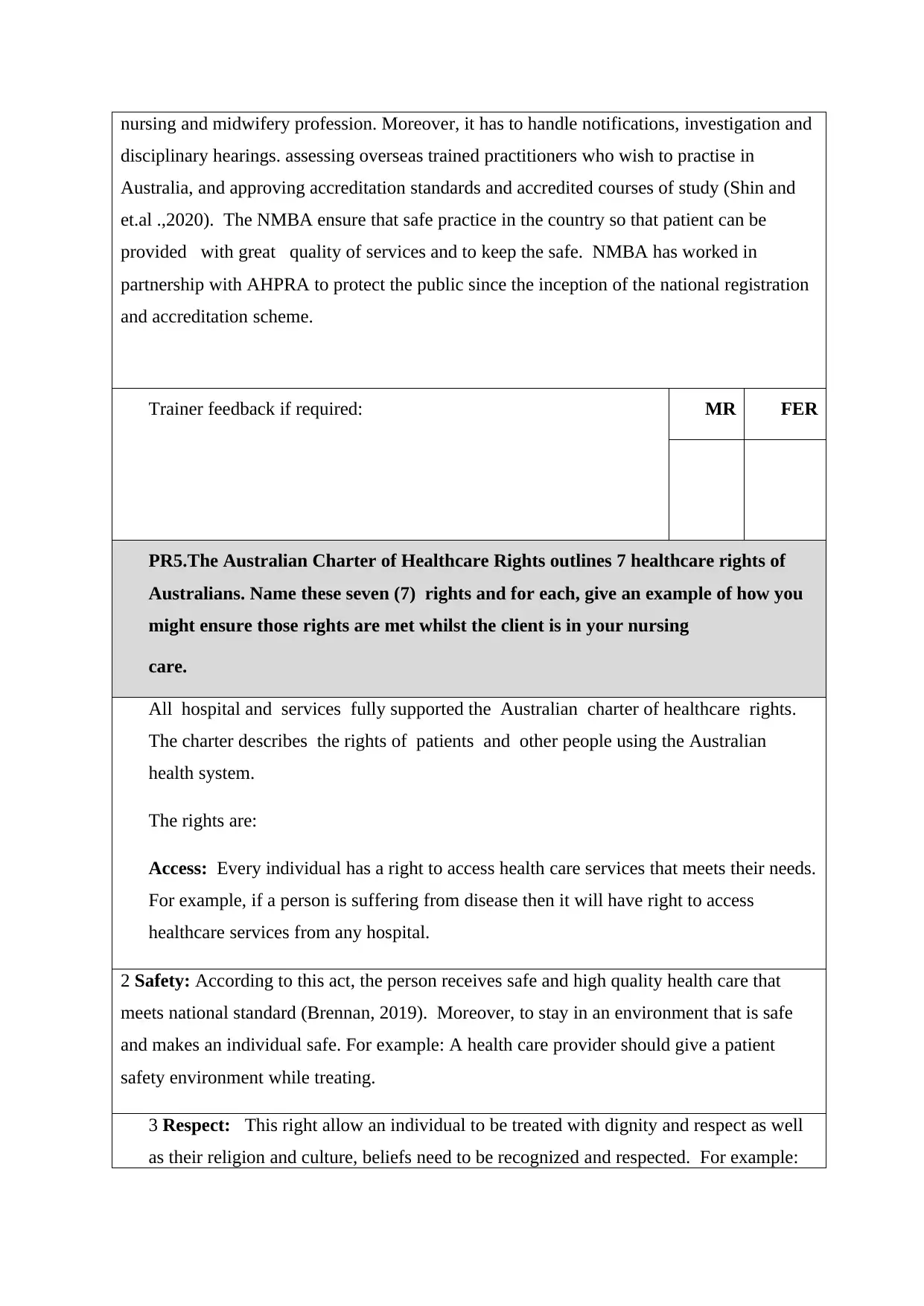
nursing and midwifery profession. Moreover, it has to handle notifications, investigation and
disciplinary hearings. assessing overseas trained practitioners who wish to practise in
Australia, and approving accreditation standards and accredited courses of study (Shin and
et.al .,2020). The NMBA ensure that safe practice in the country so that patient can be
provided with great quality of services and to keep the safe. NMBA has worked in
partnership with AHPRA to protect the public since the inception of the national registration
and accreditation scheme.
Trainer feedback if required: MR FER
PR5.The Australian Charter of Healthcare Rights outlines 7 healthcare rights of
Australians. Name these seven (7) rights and for each, give an example of how you
might ensure those rights are met whilst the client is in your nursing
care.
All hospital and services fully supported the Australian charter of healthcare rights.
The charter describes the rights of patients and other people using the Australian
health system.
The rights are:
Access: Every individual has a right to access health care services that meets their needs.
For example, if a person is suffering from disease then it will have right to access
healthcare services from any hospital.
2 Safety: According to this act, the person receives safe and high quality health care that
meets national standard (Brennan, 2019). Moreover, to stay in an environment that is safe
and makes an individual safe. For example: A health care provider should give a patient
safety environment while treating.
3 Respect: This right allow an individual to be treated with dignity and respect as well
as their religion and culture, beliefs need to be recognized and respected. For example:
disciplinary hearings. assessing overseas trained practitioners who wish to practise in
Australia, and approving accreditation standards and accredited courses of study (Shin and
et.al .,2020). The NMBA ensure that safe practice in the country so that patient can be
provided with great quality of services and to keep the safe. NMBA has worked in
partnership with AHPRA to protect the public since the inception of the national registration
and accreditation scheme.
Trainer feedback if required: MR FER
PR5.The Australian Charter of Healthcare Rights outlines 7 healthcare rights of
Australians. Name these seven (7) rights and for each, give an example of how you
might ensure those rights are met whilst the client is in your nursing
care.
All hospital and services fully supported the Australian charter of healthcare rights.
The charter describes the rights of patients and other people using the Australian
health system.
The rights are:
Access: Every individual has a right to access health care services that meets their needs.
For example, if a person is suffering from disease then it will have right to access
healthcare services from any hospital.
2 Safety: According to this act, the person receives safe and high quality health care that
meets national standard (Brennan, 2019). Moreover, to stay in an environment that is safe
and makes an individual safe. For example: A health care provider should give a patient
safety environment while treating.
3 Respect: This right allow an individual to be treated with dignity and respect as well
as their religion and culture, beliefs need to be recognized and respected. For example:
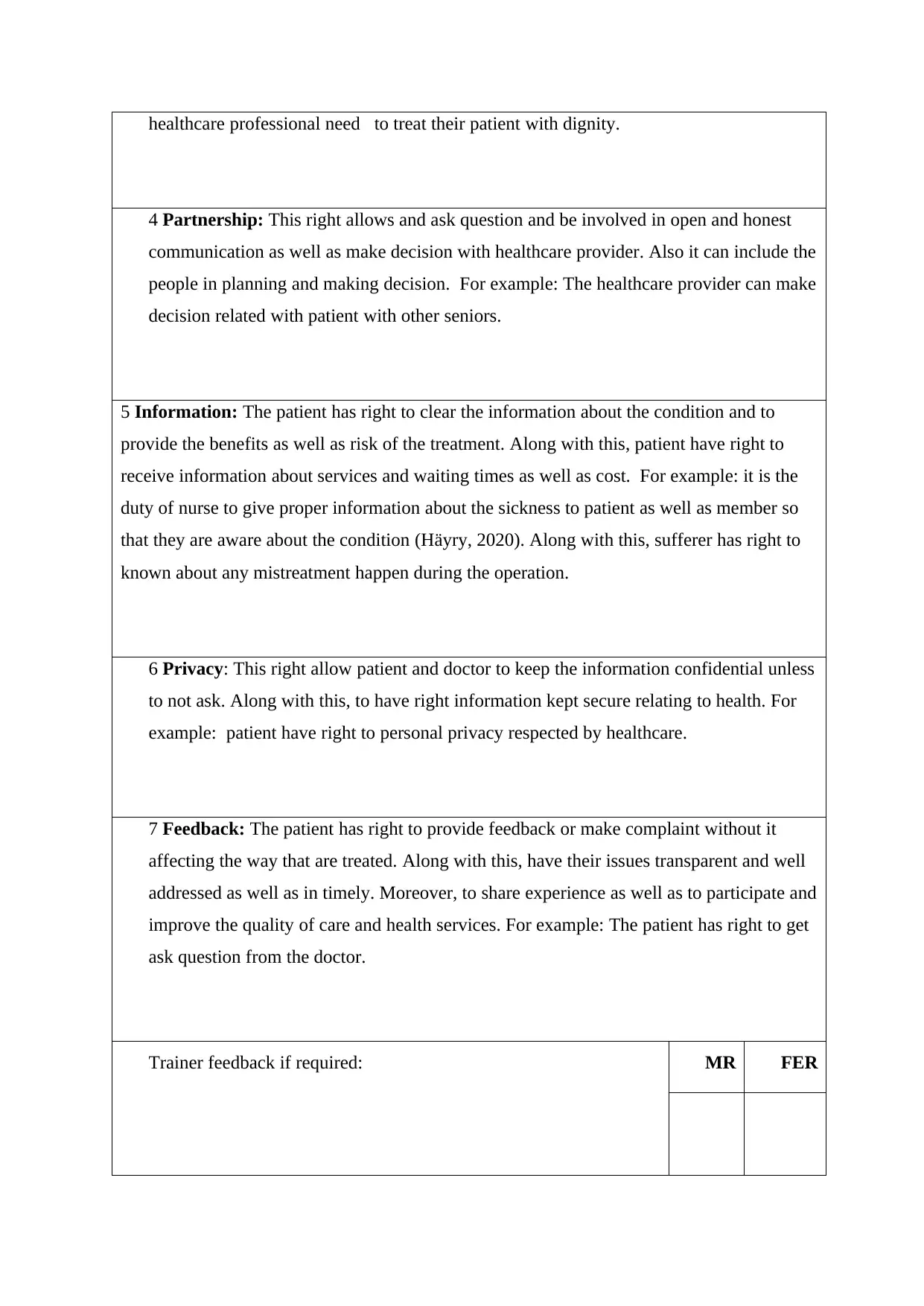
healthcare professional need to treat their patient with dignity.
4 Partnership: This right allows and ask question and be involved in open and honest
communication as well as make decision with healthcare provider. Also it can include the
people in planning and making decision. For example: The healthcare provider can make
decision related with patient with other seniors.
5 Information: The patient has right to clear the information about the condition and to
provide the benefits as well as risk of the treatment. Along with this, patient have right to
receive information about services and waiting times as well as cost. For example: it is the
duty of nurse to give proper information about the sickness to patient as well as member so
that they are aware about the condition (Häyry, 2020). Along with this, sufferer has right to
known about any mistreatment happen during the operation.
6 Privacy: This right allow patient and doctor to keep the information confidential unless
to not ask. Along with this, to have right information kept secure relating to health. For
example: patient have right to personal privacy respected by healthcare.
7 Feedback: The patient has right to provide feedback or make complaint without it
affecting the way that are treated. Along with this, have their issues transparent and well
addressed as well as in timely. Moreover, to share experience as well as to participate and
improve the quality of care and health services. For example: The patient has right to get
ask question from the doctor.
Trainer feedback if required: MR FER
4 Partnership: This right allows and ask question and be involved in open and honest
communication as well as make decision with healthcare provider. Also it can include the
people in planning and making decision. For example: The healthcare provider can make
decision related with patient with other seniors.
5 Information: The patient has right to clear the information about the condition and to
provide the benefits as well as risk of the treatment. Along with this, patient have right to
receive information about services and waiting times as well as cost. For example: it is the
duty of nurse to give proper information about the sickness to patient as well as member so
that they are aware about the condition (Häyry, 2020). Along with this, sufferer has right to
known about any mistreatment happen during the operation.
6 Privacy: This right allow patient and doctor to keep the information confidential unless
to not ask. Along with this, to have right information kept secure relating to health. For
example: patient have right to personal privacy respected by healthcare.
7 Feedback: The patient has right to provide feedback or make complaint without it
affecting the way that are treated. Along with this, have their issues transparent and well
addressed as well as in timely. Moreover, to share experience as well as to participate and
improve the quality of care and health services. For example: The patient has right to get
ask question from the doctor.
Trainer feedback if required: MR FER
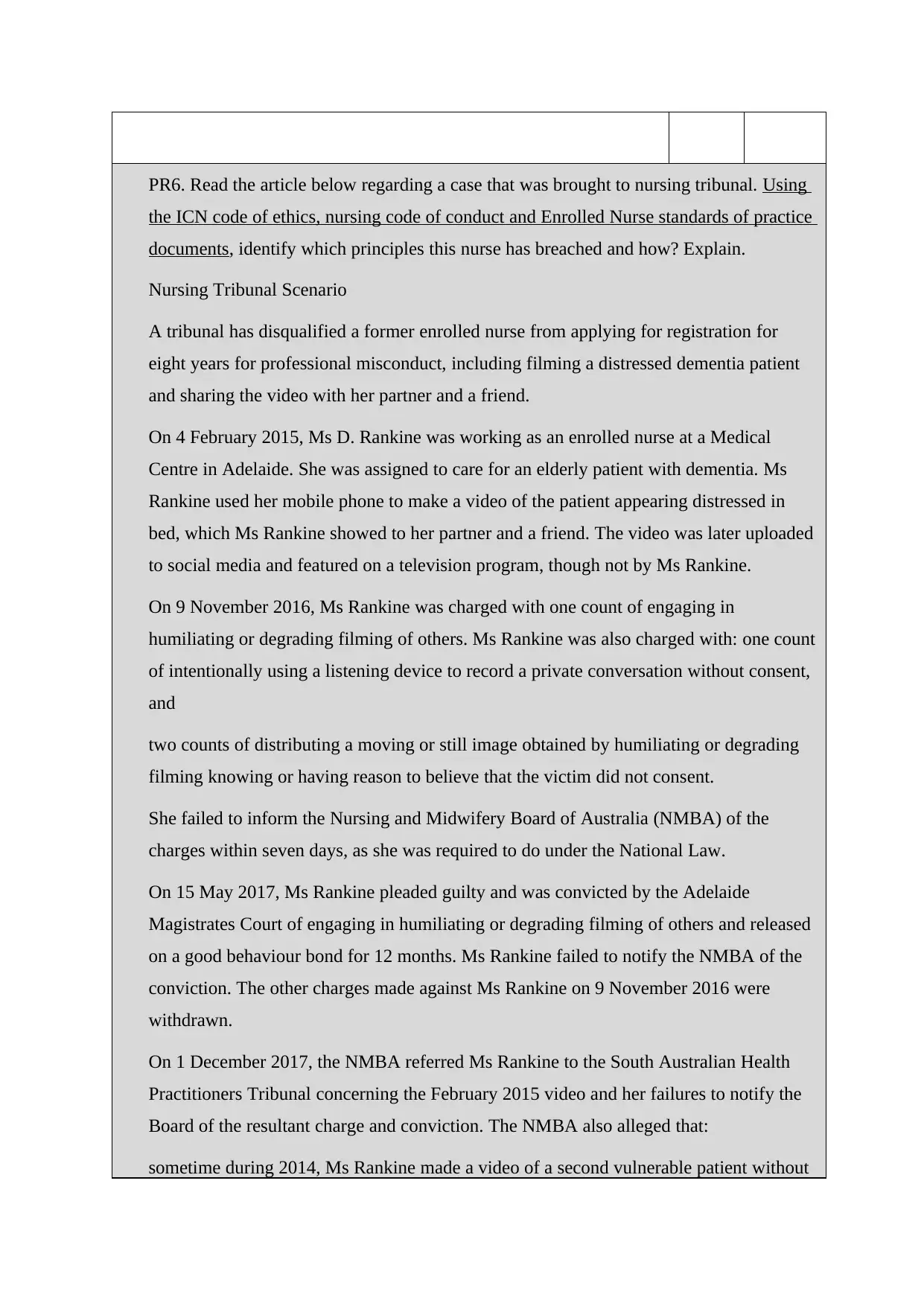
PR6. Read the article below regarding a case that was brought to nursing tribunal. Using
the ICN code of ethics, nursing code of conduct and Enrolled Nurse standards of practice
documents, identify which principles this nurse has breached and how? Explain.
Nursing Tribunal Scenario
A tribunal has disqualified a former enrolled nurse from applying for registration for
eight years for professional misconduct, including filming a distressed dementia patient
and sharing the video with her partner and a friend.
On 4 February 2015, Ms D. Rankine was working as an enrolled nurse at a Medical
Centre in Adelaide. She was assigned to care for an elderly patient with dementia. Ms
Rankine used her mobile phone to make a video of the patient appearing distressed in
bed, which Ms Rankine showed to her partner and a friend. The video was later uploaded
to social media and featured on a television program, though not by Ms Rankine.
On 9 November 2016, Ms Rankine was charged with one count of engaging in
humiliating or degrading filming of others. Ms Rankine was also charged with: one count
of intentionally using a listening device to record a private conversation without consent,
and
two counts of distributing a moving or still image obtained by humiliating or degrading
filming knowing or having reason to believe that the victim did not consent.
She failed to inform the Nursing and Midwifery Board of Australia (NMBA) of the
charges within seven days, as she was required to do under the National Law.
On 15 May 2017, Ms Rankine pleaded guilty and was convicted by the Adelaide
Magistrates Court of engaging in humiliating or degrading filming of others and released
on a good behaviour bond for 12 months. Ms Rankine failed to notify the NMBA of the
conviction. The other charges made against Ms Rankine on 9 November 2016 were
withdrawn.
On 1 December 2017, the NMBA referred Ms Rankine to the South Australian Health
Practitioners Tribunal concerning the February 2015 video and her failures to notify the
Board of the resultant charge and conviction. The NMBA also alleged that:
sometime during 2014, Ms Rankine made a video of a second vulnerable patient without
the ICN code of ethics, nursing code of conduct and Enrolled Nurse standards of practice
documents, identify which principles this nurse has breached and how? Explain.
Nursing Tribunal Scenario
A tribunal has disqualified a former enrolled nurse from applying for registration for
eight years for professional misconduct, including filming a distressed dementia patient
and sharing the video with her partner and a friend.
On 4 February 2015, Ms D. Rankine was working as an enrolled nurse at a Medical
Centre in Adelaide. She was assigned to care for an elderly patient with dementia. Ms
Rankine used her mobile phone to make a video of the patient appearing distressed in
bed, which Ms Rankine showed to her partner and a friend. The video was later uploaded
to social media and featured on a television program, though not by Ms Rankine.
On 9 November 2016, Ms Rankine was charged with one count of engaging in
humiliating or degrading filming of others. Ms Rankine was also charged with: one count
of intentionally using a listening device to record a private conversation without consent,
and
two counts of distributing a moving or still image obtained by humiliating or degrading
filming knowing or having reason to believe that the victim did not consent.
She failed to inform the Nursing and Midwifery Board of Australia (NMBA) of the
charges within seven days, as she was required to do under the National Law.
On 15 May 2017, Ms Rankine pleaded guilty and was convicted by the Adelaide
Magistrates Court of engaging in humiliating or degrading filming of others and released
on a good behaviour bond for 12 months. Ms Rankine failed to notify the NMBA of the
conviction. The other charges made against Ms Rankine on 9 November 2016 were
withdrawn.
On 1 December 2017, the NMBA referred Ms Rankine to the South Australian Health
Practitioners Tribunal concerning the February 2015 video and her failures to notify the
Board of the resultant charge and conviction. The NMBA also alleged that:
sometime during 2014, Ms Rankine made a video of a second vulnerable patient without
Paraphrase This Document
Need a fresh take? Get an instant paraphrase of this document with our AI Paraphraser
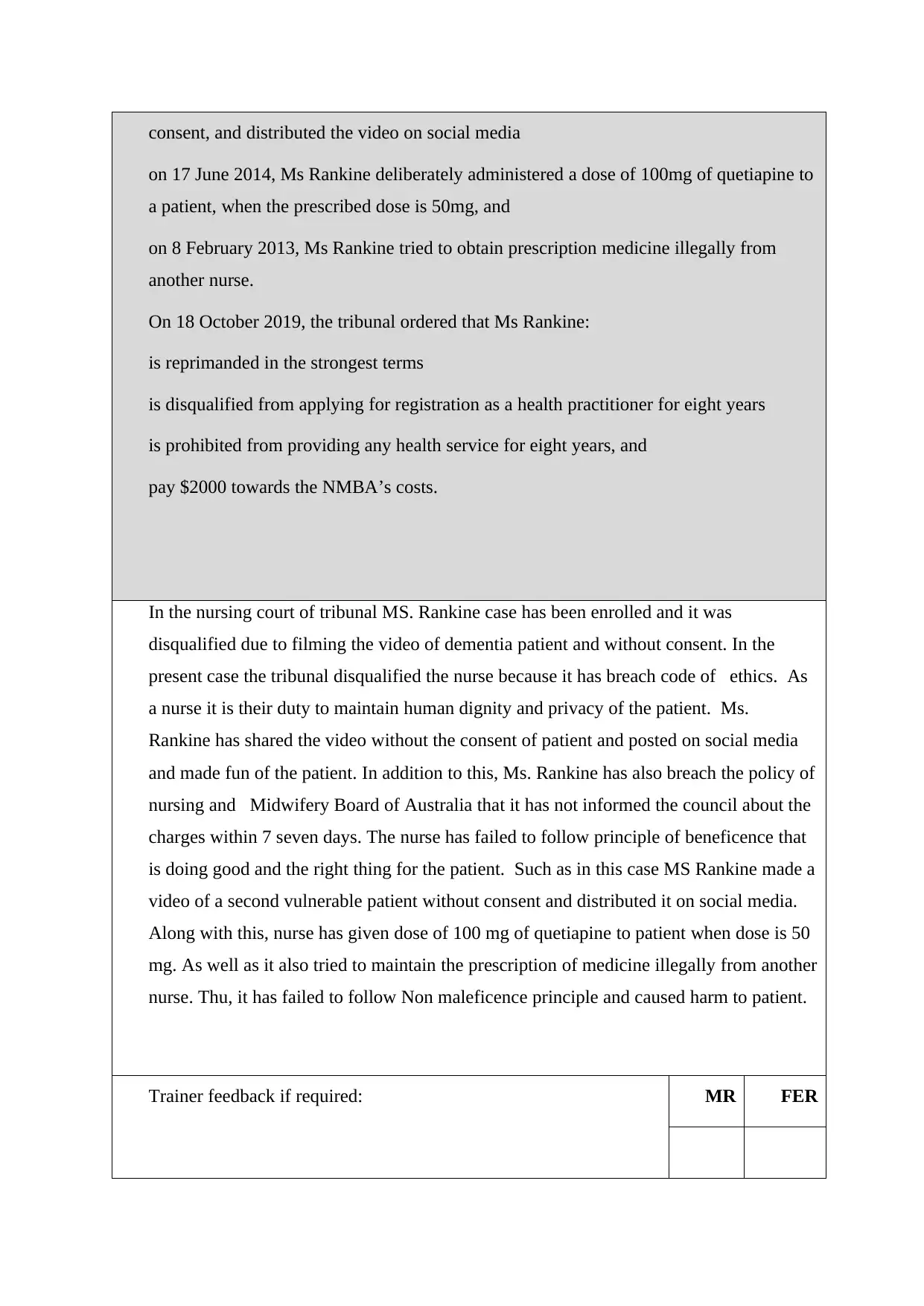
consent, and distributed the video on social media
on 17 June 2014, Ms Rankine deliberately administered a dose of 100mg of quetiapine to
a patient, when the prescribed dose is 50mg, and
on 8 February 2013, Ms Rankine tried to obtain prescription medicine illegally from
another nurse.
On 18 October 2019, the tribunal ordered that Ms Rankine:
is reprimanded in the strongest terms
is disqualified from applying for registration as a health practitioner for eight years
is prohibited from providing any health service for eight years, and
pay $2000 towards the NMBA’s costs.
In the nursing court of tribunal MS. Rankine case has been enrolled and it was
disqualified due to filming the video of dementia patient and without consent. In the
present case the tribunal disqualified the nurse because it has breach code of ethics. As
a nurse it is their duty to maintain human dignity and privacy of the patient. Ms.
Rankine has shared the video without the consent of patient and posted on social media
and made fun of the patient. In addition to this, Ms. Rankine has also breach the policy of
nursing and Midwifery Board of Australia that it has not informed the council about the
charges within 7 seven days. The nurse has failed to follow principle of beneficence that
is doing good and the right thing for the patient. Such as in this case MS Rankine made a
video of a second vulnerable patient without consent and distributed it on social media.
Along with this, nurse has given dose of 100 mg of quetiapine to patient when dose is 50
mg. As well as it also tried to maintain the prescription of medicine illegally from another
nurse. Thu, it has failed to follow Non maleficence principle and caused harm to patient.
Trainer feedback if required: MR FER
on 17 June 2014, Ms Rankine deliberately administered a dose of 100mg of quetiapine to
a patient, when the prescribed dose is 50mg, and
on 8 February 2013, Ms Rankine tried to obtain prescription medicine illegally from
another nurse.
On 18 October 2019, the tribunal ordered that Ms Rankine:
is reprimanded in the strongest terms
is disqualified from applying for registration as a health practitioner for eight years
is prohibited from providing any health service for eight years, and
pay $2000 towards the NMBA’s costs.
In the nursing court of tribunal MS. Rankine case has been enrolled and it was
disqualified due to filming the video of dementia patient and without consent. In the
present case the tribunal disqualified the nurse because it has breach code of ethics. As
a nurse it is their duty to maintain human dignity and privacy of the patient. Ms.
Rankine has shared the video without the consent of patient and posted on social media
and made fun of the patient. In addition to this, Ms. Rankine has also breach the policy of
nursing and Midwifery Board of Australia that it has not informed the council about the
charges within 7 seven days. The nurse has failed to follow principle of beneficence that
is doing good and the right thing for the patient. Such as in this case MS Rankine made a
video of a second vulnerable patient without consent and distributed it on social media.
Along with this, nurse has given dose of 100 mg of quetiapine to patient when dose is 50
mg. As well as it also tried to maintain the prescription of medicine illegally from another
nurse. Thu, it has failed to follow Non maleficence principle and caused harm to patient.
Trainer feedback if required: MR FER
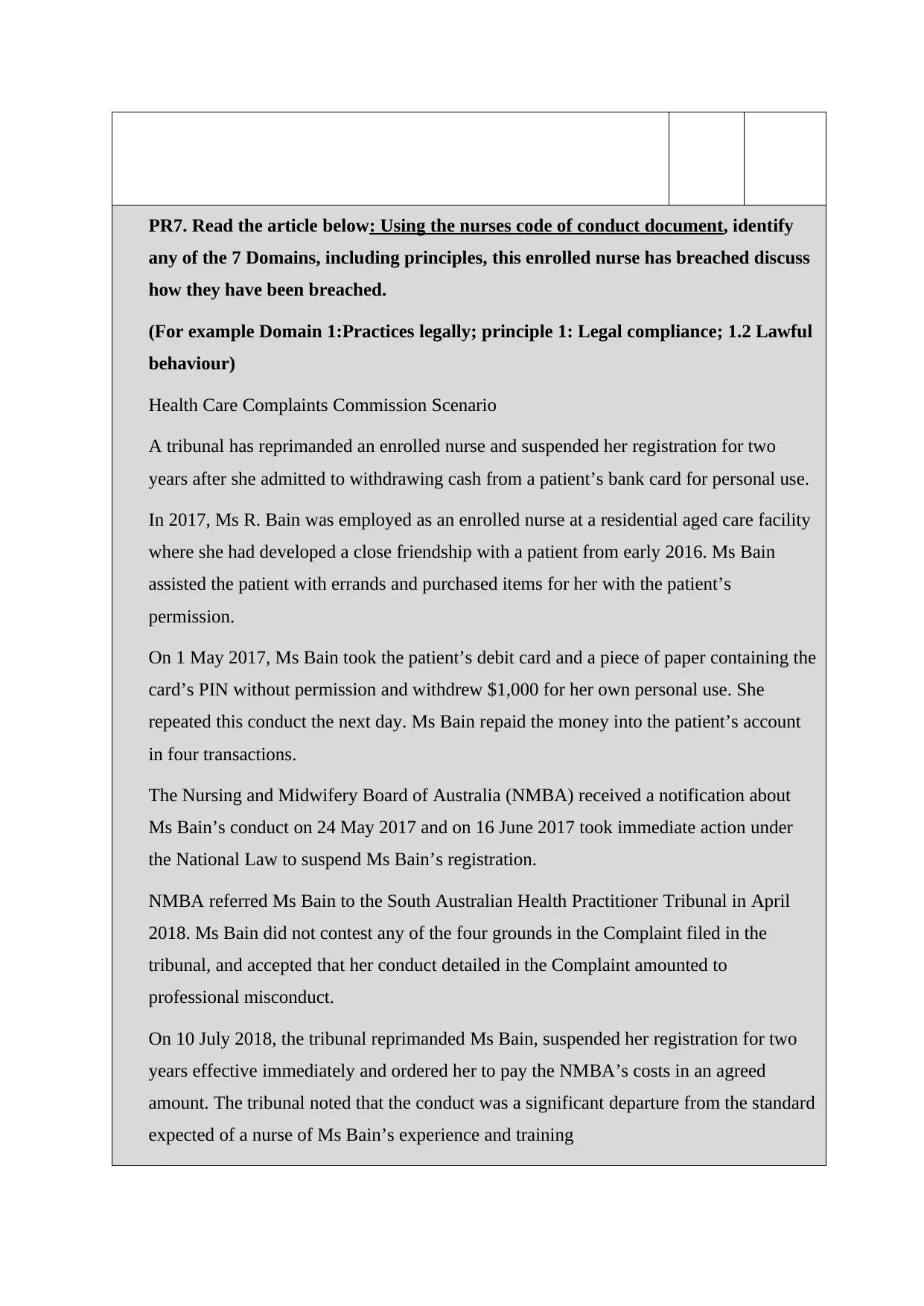
PR7. Read the article below: Using the nurses code of conduct document, identify
any of the 7 Domains, including principles, this enrolled nurse has breached discuss
how they have been breached.
(For example Domain 1:Practices legally; principle 1: Legal compliance; 1.2 Lawful
behaviour)
Health Care Complaints Commission Scenario
A tribunal has reprimanded an enrolled nurse and suspended her registration for two
years after she admitted to withdrawing cash from a patient’s bank card for personal use.
In 2017, Ms R. Bain was employed as an enrolled nurse at a residential aged care facility
where she had developed a close friendship with a patient from early 2016. Ms Bain
assisted the patient with errands and purchased items for her with the patient’s
permission.
On 1 May 2017, Ms Bain took the patient’s debit card and a piece of paper containing the
card’s PIN without permission and withdrew $1,000 for her own personal use. She
repeated this conduct the next day. Ms Bain repaid the money into the patient’s account
in four transactions.
The Nursing and Midwifery Board of Australia (NMBA) received a notification about
Ms Bain’s conduct on 24 May 2017 and on 16 June 2017 took immediate action under
the National Law to suspend Ms Bain’s registration.
NMBA referred Ms Bain to the South Australian Health Practitioner Tribunal in April
2018. Ms Bain did not contest any of the four grounds in the Complaint filed in the
tribunal, and accepted that her conduct detailed in the Complaint amounted to
professional misconduct.
On 10 July 2018, the tribunal reprimanded Ms Bain, suspended her registration for two
years effective immediately and ordered her to pay the NMBA’s costs in an agreed
amount. The tribunal noted that the conduct was a significant departure from the standard
expected of a nurse of Ms Bain’s experience and training
any of the 7 Domains, including principles, this enrolled nurse has breached discuss
how they have been breached.
(For example Domain 1:Practices legally; principle 1: Legal compliance; 1.2 Lawful
behaviour)
Health Care Complaints Commission Scenario
A tribunal has reprimanded an enrolled nurse and suspended her registration for two
years after she admitted to withdrawing cash from a patient’s bank card for personal use.
In 2017, Ms R. Bain was employed as an enrolled nurse at a residential aged care facility
where she had developed a close friendship with a patient from early 2016. Ms Bain
assisted the patient with errands and purchased items for her with the patient’s
permission.
On 1 May 2017, Ms Bain took the patient’s debit card and a piece of paper containing the
card’s PIN without permission and withdrew $1,000 for her own personal use. She
repeated this conduct the next day. Ms Bain repaid the money into the patient’s account
in four transactions.
The Nursing and Midwifery Board of Australia (NMBA) received a notification about
Ms Bain’s conduct on 24 May 2017 and on 16 June 2017 took immediate action under
the National Law to suspend Ms Bain’s registration.
NMBA referred Ms Bain to the South Australian Health Practitioner Tribunal in April
2018. Ms Bain did not contest any of the four grounds in the Complaint filed in the
tribunal, and accepted that her conduct detailed in the Complaint amounted to
professional misconduct.
On 10 July 2018, the tribunal reprimanded Ms Bain, suspended her registration for two
years effective immediately and ordered her to pay the NMBA’s costs in an agreed
amount. The tribunal noted that the conduct was a significant departure from the standard
expected of a nurse of Ms Bain’s experience and training
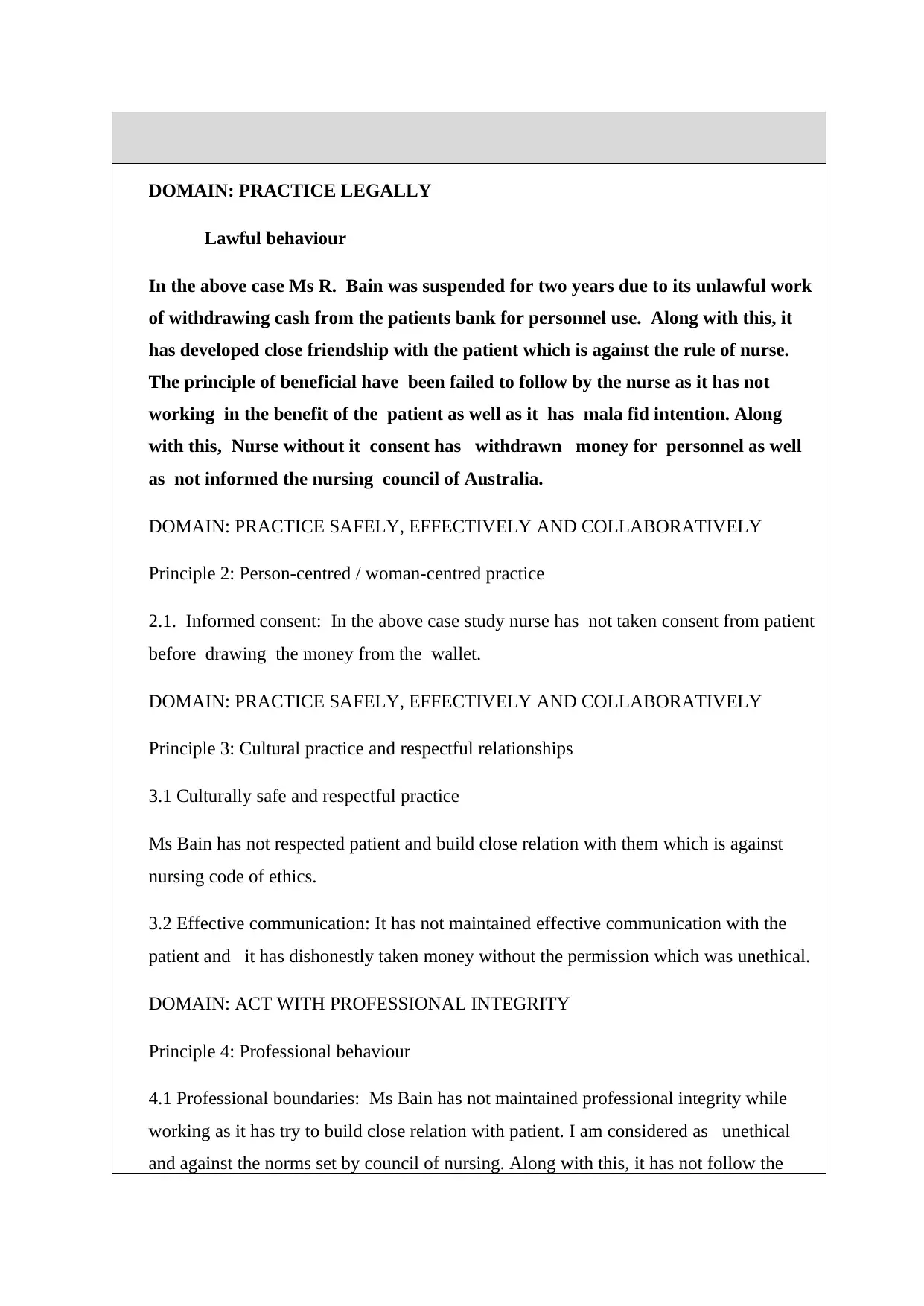
DOMAIN: PRACTICE LEGALLY
Lawful behaviour
In the above case Ms R. Bain was suspended for two years due to its unlawful work
of withdrawing cash from the patients bank for personnel use. Along with this, it
has developed close friendship with the patient which is against the rule of nurse.
The principle of beneficial have been failed to follow by the nurse as it has not
working in the benefit of the patient as well as it has mala fid intention. Along
with this, Nurse without it consent has withdrawn money for personnel as well
as not informed the nursing council of Australia.
DOMAIN: PRACTICE SAFELY, EFFECTIVELY AND COLLABORATIVELY
Principle 2: Person-centred / woman-centred practice
2.1. Informed consent: In the above case study nurse has not taken consent from patient
before drawing the money from the wallet.
DOMAIN: PRACTICE SAFELY, EFFECTIVELY AND COLLABORATIVELY
Principle 3: Cultural practice and respectful relationships
3.1 Culturally safe and respectful practice
Ms Bain has not respected patient and build close relation with them which is against
nursing code of ethics.
3.2 Effective communication: It has not maintained effective communication with the
patient and it has dishonestly taken money without the permission which was unethical.
DOMAIN: ACT WITH PROFESSIONAL INTEGRITY
Principle 4: Professional behaviour
4.1 Professional boundaries: Ms Bain has not maintained professional integrity while
working as it has try to build close relation with patient. I am considered as unethical
and against the norms set by council of nursing. Along with this, it has not follow the
Lawful behaviour
In the above case Ms R. Bain was suspended for two years due to its unlawful work
of withdrawing cash from the patients bank for personnel use. Along with this, it
has developed close friendship with the patient which is against the rule of nurse.
The principle of beneficial have been failed to follow by the nurse as it has not
working in the benefit of the patient as well as it has mala fid intention. Along
with this, Nurse without it consent has withdrawn money for personnel as well
as not informed the nursing council of Australia.
DOMAIN: PRACTICE SAFELY, EFFECTIVELY AND COLLABORATIVELY
Principle 2: Person-centred / woman-centred practice
2.1. Informed consent: In the above case study nurse has not taken consent from patient
before drawing the money from the wallet.
DOMAIN: PRACTICE SAFELY, EFFECTIVELY AND COLLABORATIVELY
Principle 3: Cultural practice and respectful relationships
3.1 Culturally safe and respectful practice
Ms Bain has not respected patient and build close relation with them which is against
nursing code of ethics.
3.2 Effective communication: It has not maintained effective communication with the
patient and it has dishonestly taken money without the permission which was unethical.
DOMAIN: ACT WITH PROFESSIONAL INTEGRITY
Principle 4: Professional behaviour
4.1 Professional boundaries: Ms Bain has not maintained professional integrity while
working as it has try to build close relation with patient. I am considered as unethical
and against the norms set by council of nursing. Along with this, it has not follow the
Secure Best Marks with AI Grader
Need help grading? Try our AI Grader for instant feedback on your assignments.
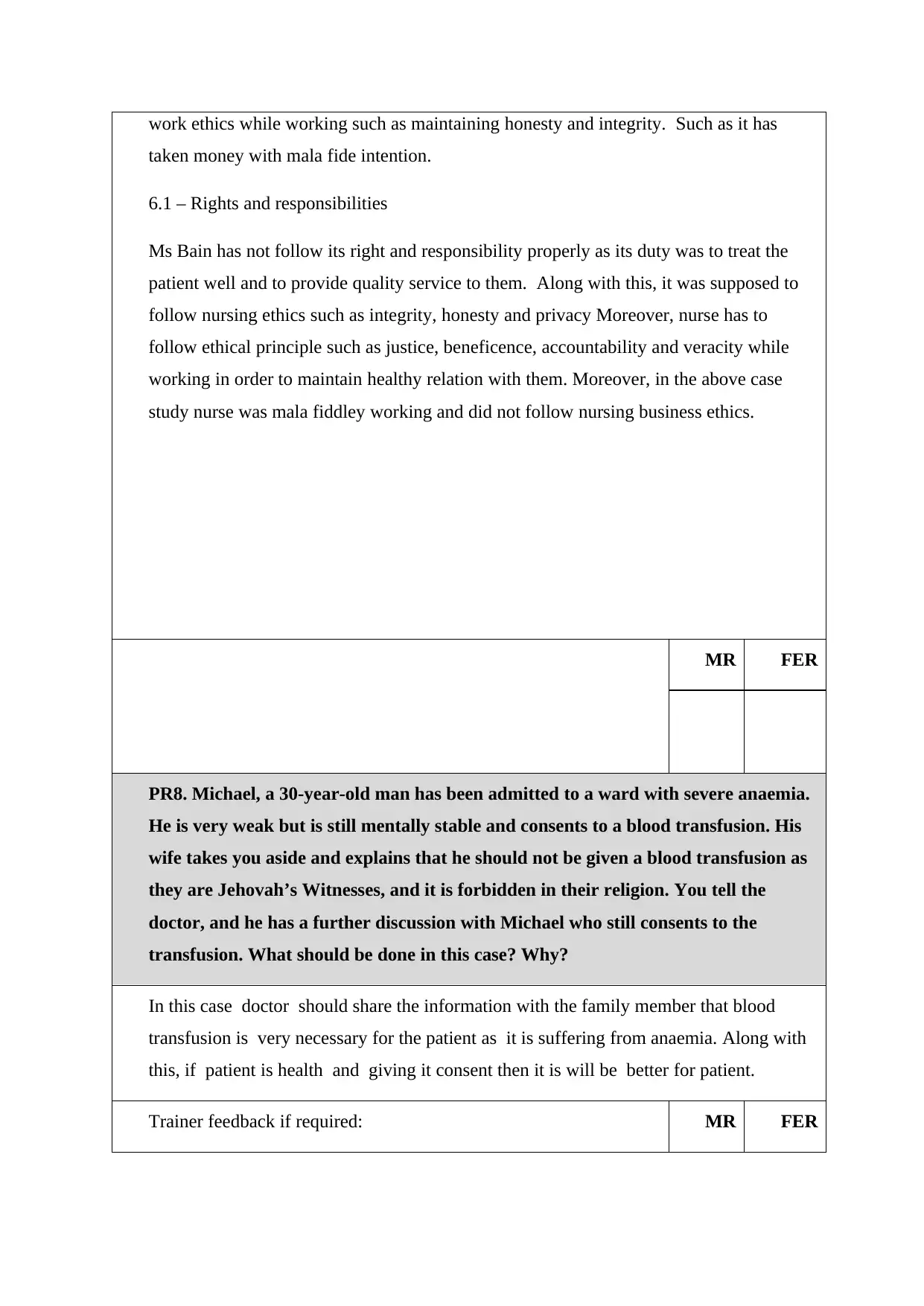
work ethics while working such as maintaining honesty and integrity. Such as it has
taken money with mala fide intention.
6.1 – Rights and responsibilities
Ms Bain has not follow its right and responsibility properly as its duty was to treat the
patient well and to provide quality service to them. Along with this, it was supposed to
follow nursing ethics such as integrity, honesty and privacy Moreover, nurse has to
follow ethical principle such as justice, beneficence, accountability and veracity while
working in order to maintain healthy relation with them. Moreover, in the above case
study nurse was mala fiddley working and did not follow nursing business ethics.
MR FER
PR8. Michael, a 30-year-old man has been admitted to a ward with severe anaemia.
He is very weak but is still mentally stable and consents to a blood transfusion. His
wife takes you aside and explains that he should not be given a blood transfusion as
they are Jehovah’s Witnesses, and it is forbidden in their religion. You tell the
doctor, and he has a further discussion with Michael who still consents to the
transfusion. What should be done in this case? Why?
In this case doctor should share the information with the family member that blood
transfusion is very necessary for the patient as it is suffering from anaemia. Along with
this, if patient is health and giving it consent then it is will be better for patient.
Trainer feedback if required: MR FER
taken money with mala fide intention.
6.1 – Rights and responsibilities
Ms Bain has not follow its right and responsibility properly as its duty was to treat the
patient well and to provide quality service to them. Along with this, it was supposed to
follow nursing ethics such as integrity, honesty and privacy Moreover, nurse has to
follow ethical principle such as justice, beneficence, accountability and veracity while
working in order to maintain healthy relation with them. Moreover, in the above case
study nurse was mala fiddley working and did not follow nursing business ethics.
MR FER
PR8. Michael, a 30-year-old man has been admitted to a ward with severe anaemia.
He is very weak but is still mentally stable and consents to a blood transfusion. His
wife takes you aside and explains that he should not be given a blood transfusion as
they are Jehovah’s Witnesses, and it is forbidden in their religion. You tell the
doctor, and he has a further discussion with Michael who still consents to the
transfusion. What should be done in this case? Why?
In this case doctor should share the information with the family member that blood
transfusion is very necessary for the patient as it is suffering from anaemia. Along with
this, if patient is health and giving it consent then it is will be better for patient.
Trainer feedback if required: MR FER
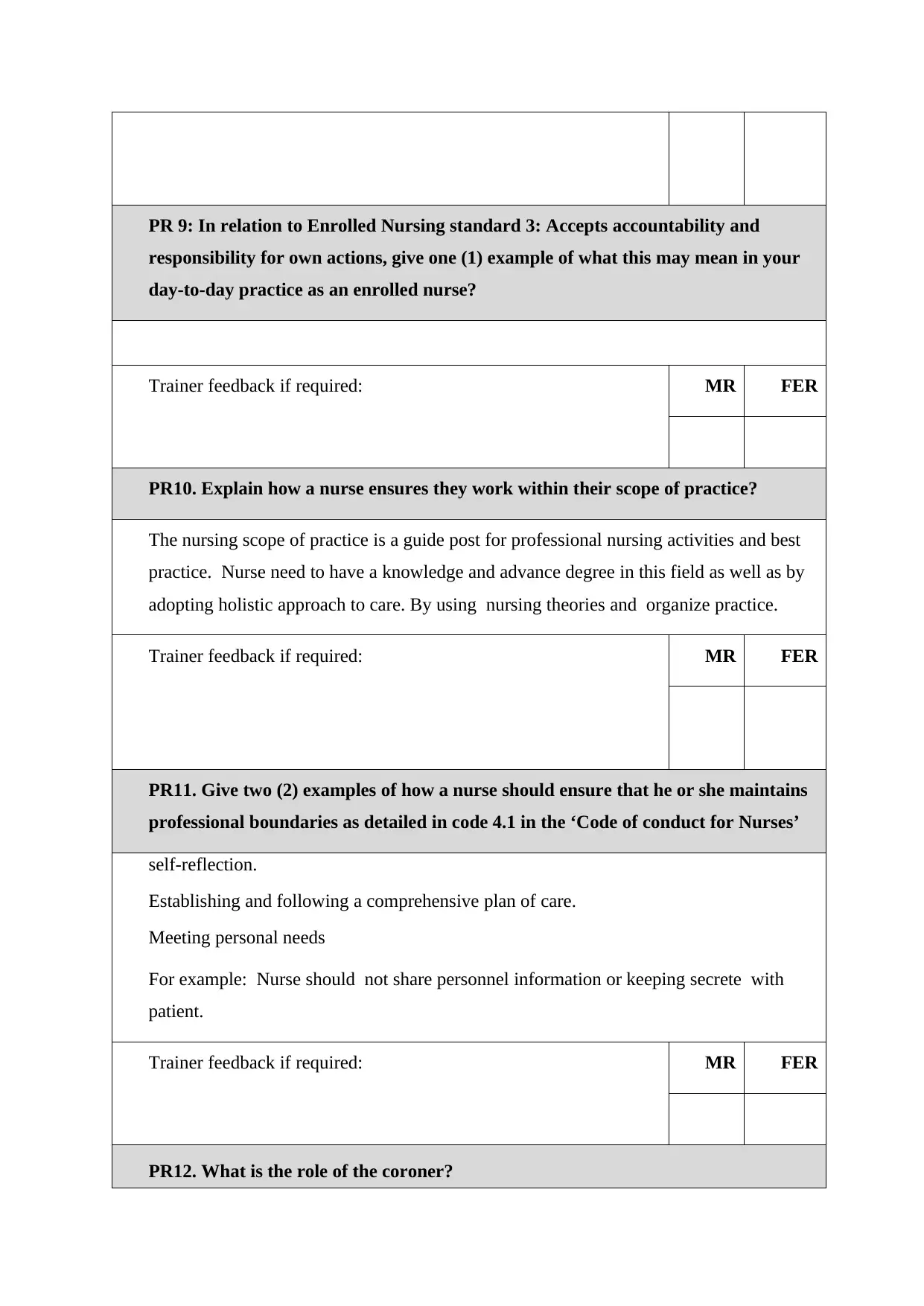
PR 9: In relation to Enrolled Nursing standard 3: Accepts accountability and
responsibility for own actions, give one (1) example of what this may mean in your
day-to-day practice as an enrolled nurse?
Trainer feedback if required: MR FER
PR10. Explain how a nurse ensures they work within their scope of practice?
The nursing scope of practice is a guide post for professional nursing activities and best
practice. Nurse need to have a knowledge and advance degree in this field as well as by
adopting holistic approach to care. By using nursing theories and organize practice.
Trainer feedback if required: MR FER
PR11. Give two (2) examples of how a nurse should ensure that he or she maintains
professional boundaries as detailed in code 4.1 in the ‘Code of conduct for Nurses’
self-reflection.
Establishing and following a comprehensive plan of care.
Meeting personal needs
For example: Nurse should not share personnel information or keeping secrete with
patient.
Trainer feedback if required: MR FER
PR12. What is the role of the coroner?
responsibility for own actions, give one (1) example of what this may mean in your
day-to-day practice as an enrolled nurse?
Trainer feedback if required: MR FER
PR10. Explain how a nurse ensures they work within their scope of practice?
The nursing scope of practice is a guide post for professional nursing activities and best
practice. Nurse need to have a knowledge and advance degree in this field as well as by
adopting holistic approach to care. By using nursing theories and organize practice.
Trainer feedback if required: MR FER
PR11. Give two (2) examples of how a nurse should ensure that he or she maintains
professional boundaries as detailed in code 4.1 in the ‘Code of conduct for Nurses’
self-reflection.
Establishing and following a comprehensive plan of care.
Meeting personal needs
For example: Nurse should not share personnel information or keeping secrete with
patient.
Trainer feedback if required: MR FER
PR12. What is the role of the coroner?
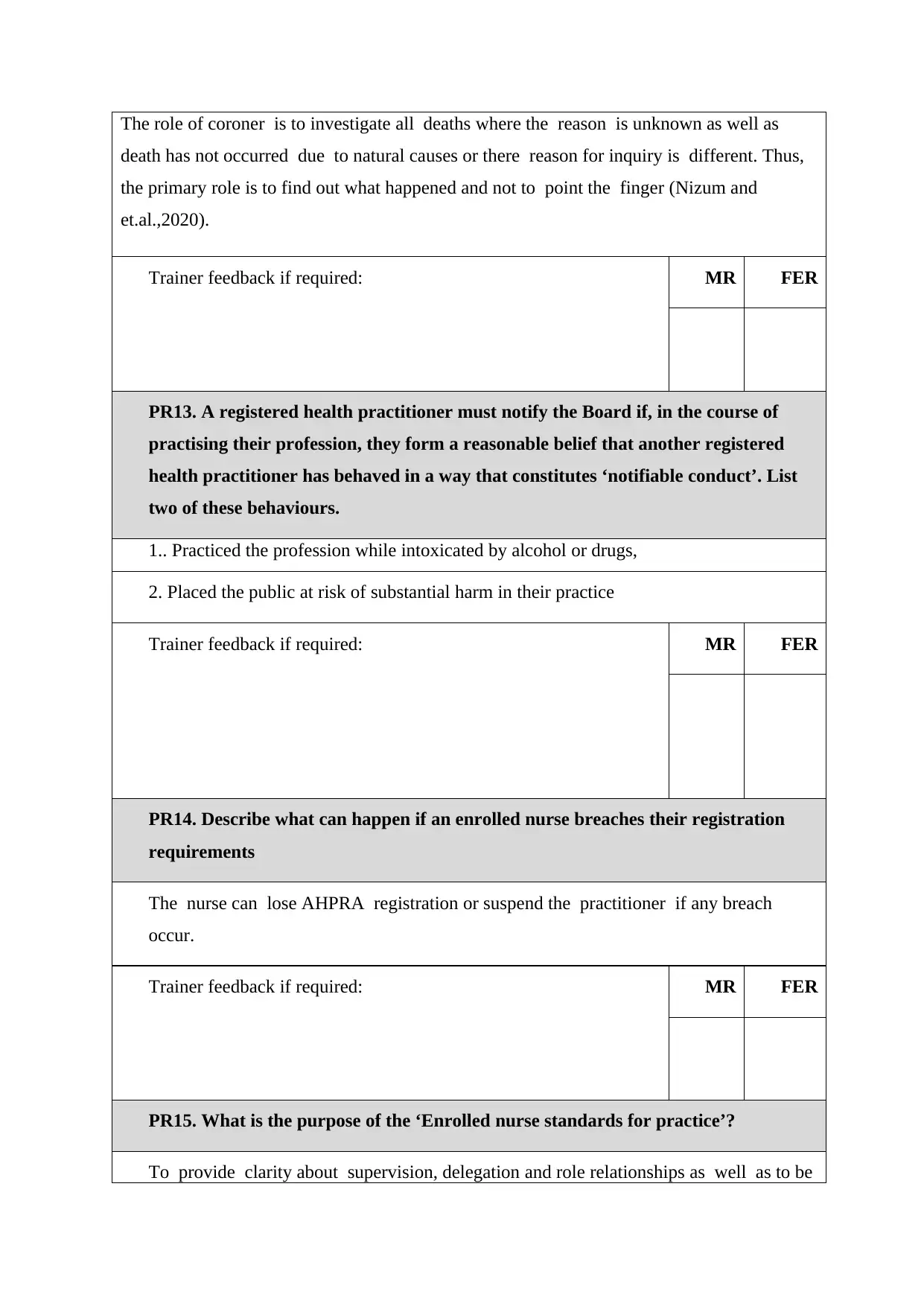
The role of coroner is to investigate all deaths where the reason is unknown as well as
death has not occurred due to natural causes or there reason for inquiry is different. Thus,
the primary role is to find out what happened and not to point the finger (Nizum and
et.al.,2020).
Trainer feedback if required: MR FER
PR13. A registered health practitioner must notify the Board if, in the course of
practising their profession, they form a reasonable belief that another registered
health practitioner has behaved in a way that constitutes ‘notifiable conduct’. List
two of these behaviours.
1.. Practiced the profession while intoxicated by alcohol or drugs,
2. Placed the public at risk of substantial harm in their practice
Trainer feedback if required: MR FER
PR14. Describe what can happen if an enrolled nurse breaches their registration
requirements
The nurse can lose AHPRA registration or suspend the practitioner if any breach
occur.
Trainer feedback if required: MR FER
PR15. What is the purpose of the ‘Enrolled nurse standards for practice’?
To provide clarity about supervision, delegation and role relationships as well as to be
death has not occurred due to natural causes or there reason for inquiry is different. Thus,
the primary role is to find out what happened and not to point the finger (Nizum and
et.al.,2020).
Trainer feedback if required: MR FER
PR13. A registered health practitioner must notify the Board if, in the course of
practising their profession, they form a reasonable belief that another registered
health practitioner has behaved in a way that constitutes ‘notifiable conduct’. List
two of these behaviours.
1.. Practiced the profession while intoxicated by alcohol or drugs,
2. Placed the public at risk of substantial harm in their practice
Trainer feedback if required: MR FER
PR14. Describe what can happen if an enrolled nurse breaches their registration
requirements
The nurse can lose AHPRA registration or suspend the practitioner if any breach
occur.
Trainer feedback if required: MR FER
PR15. What is the purpose of the ‘Enrolled nurse standards for practice’?
To provide clarity about supervision, delegation and role relationships as well as to be
Paraphrase This Document
Need a fresh take? Get an instant paraphrase of this document with our AI Paraphraser
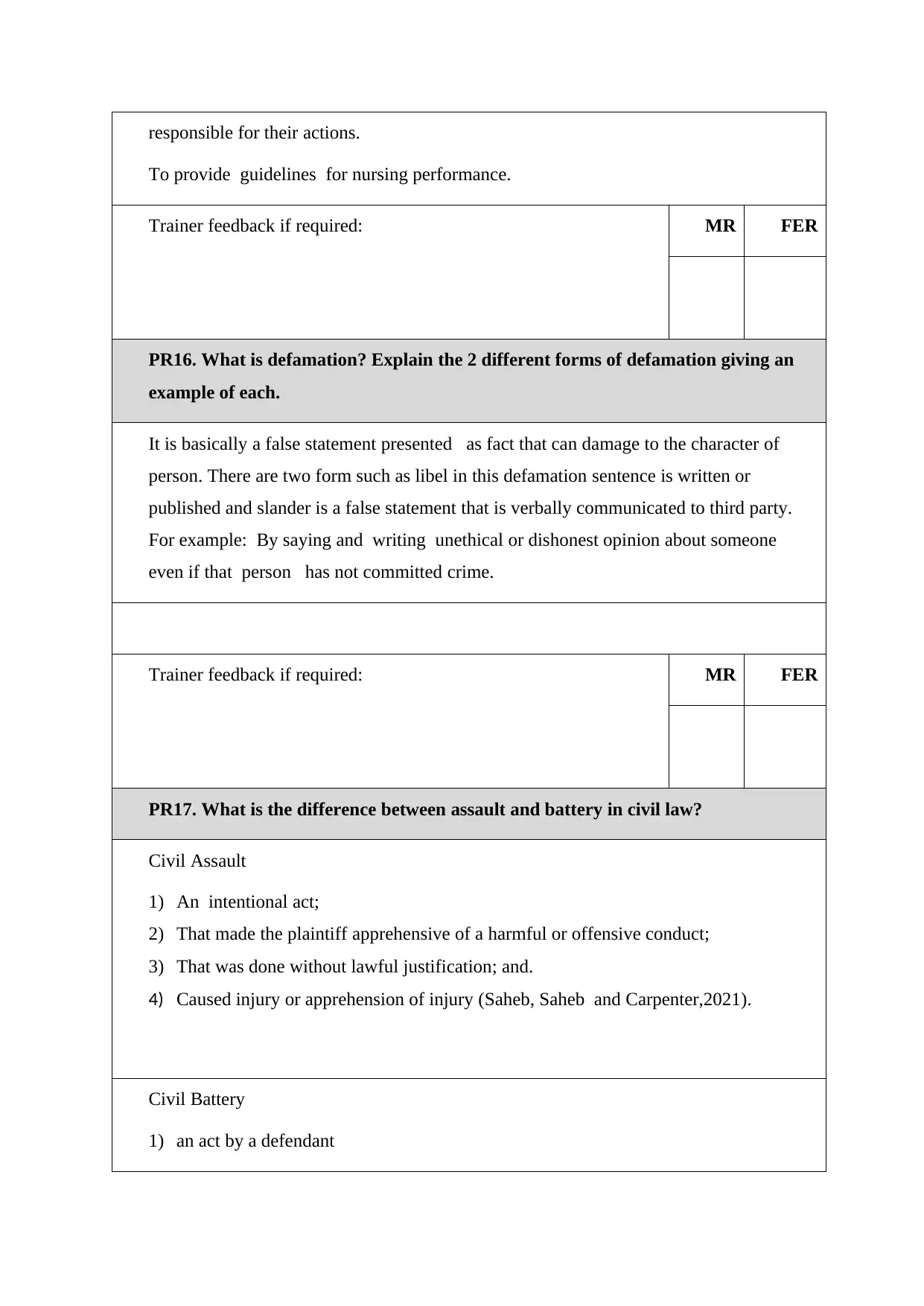
responsible for their actions.
To provide guidelines for nursing performance.
Trainer feedback if required: MR FER
PR16. What is defamation? Explain the 2 different forms of defamation giving an
example of each.
It is basically a false statement presented as fact that can damage to the character of
person. There are two form such as libel in this defamation sentence is written or
published and slander is a false statement that is verbally communicated to third party.
For example: By saying and writing unethical or dishonest opinion about someone
even if that person has not committed crime.
Trainer feedback if required: MR FER
PR17. What is the difference between assault and battery in civil law?
Civil Assault
1) An intentional act;
2) That made the plaintiff apprehensive of a harmful or offensive conduct;
3) That was done without lawful justification; and.
4) Caused injury or apprehension of injury (Saheb, Saheb and Carpenter,2021).
Civil Battery
1) an act by a defendant
To provide guidelines for nursing performance.
Trainer feedback if required: MR FER
PR16. What is defamation? Explain the 2 different forms of defamation giving an
example of each.
It is basically a false statement presented as fact that can damage to the character of
person. There are two form such as libel in this defamation sentence is written or
published and slander is a false statement that is verbally communicated to third party.
For example: By saying and writing unethical or dishonest opinion about someone
even if that person has not committed crime.
Trainer feedback if required: MR FER
PR17. What is the difference between assault and battery in civil law?
Civil Assault
1) An intentional act;
2) That made the plaintiff apprehensive of a harmful or offensive conduct;
3) That was done without lawful justification; and.
4) Caused injury or apprehension of injury (Saheb, Saheb and Carpenter,2021).
Civil Battery
1) an act by a defendant
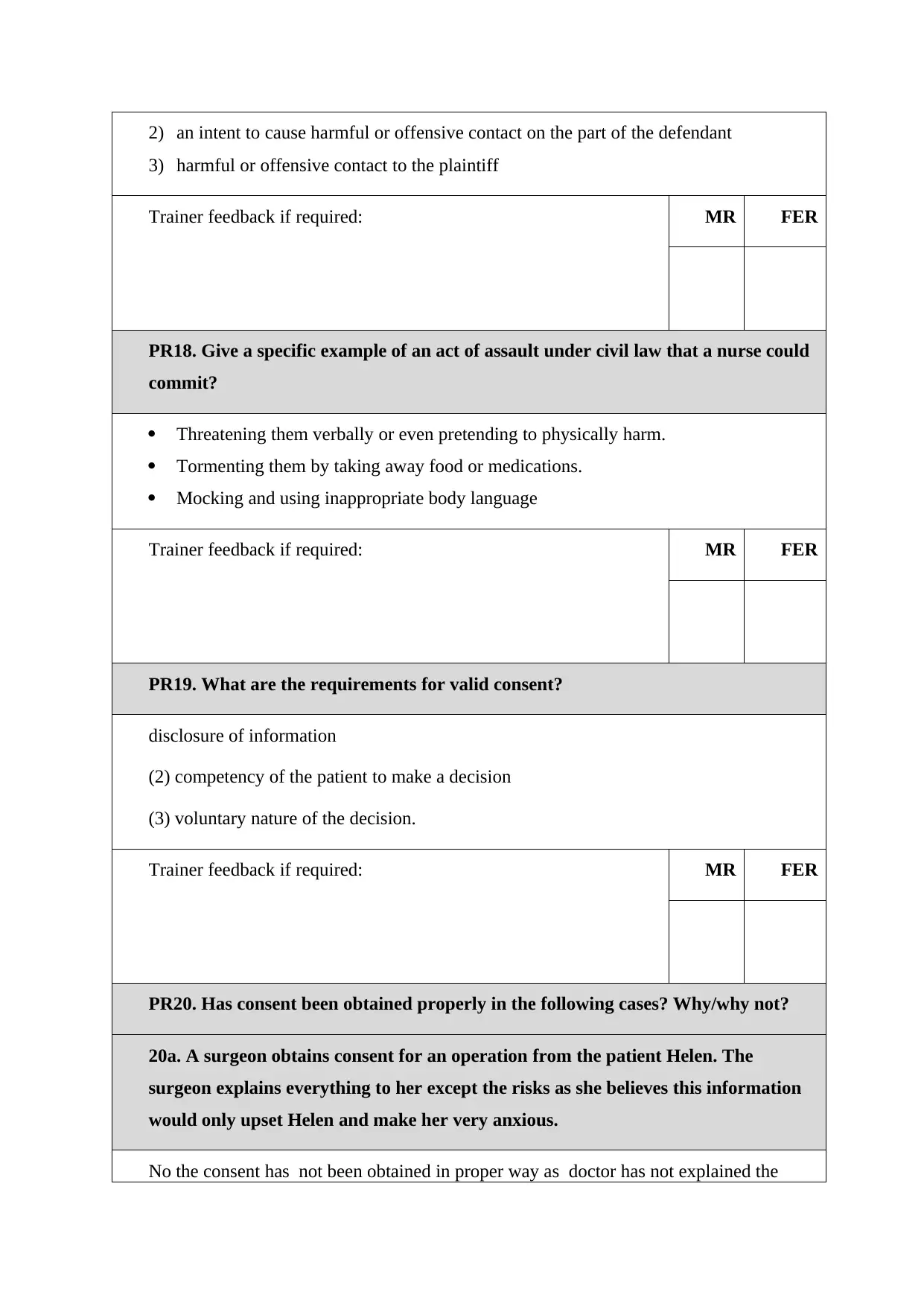
2) an intent to cause harmful or offensive contact on the part of the defendant
3) harmful or offensive contact to the plaintiff
Trainer feedback if required: MR FER
PR18. Give a specific example of an act of assault under civil law that a nurse could
commit?
Threatening them verbally or even pretending to physically harm.
Tormenting them by taking away food or medications.
Mocking and using inappropriate body language
Trainer feedback if required: MR FER
PR19. What are the requirements for valid consent?
disclosure of information
(2) competency of the patient to make a decision
(3) voluntary nature of the decision.
Trainer feedback if required: MR FER
PR20. Has consent been obtained properly in the following cases? Why/why not?
20a. A surgeon obtains consent for an operation from the patient Helen. The
surgeon explains everything to her except the risks as she believes this information
would only upset Helen and make her very anxious.
No the consent has not been obtained in proper way as doctor has not explained the
3) harmful or offensive contact to the plaintiff
Trainer feedback if required: MR FER
PR18. Give a specific example of an act of assault under civil law that a nurse could
commit?
Threatening them verbally or even pretending to physically harm.
Tormenting them by taking away food or medications.
Mocking and using inappropriate body language
Trainer feedback if required: MR FER
PR19. What are the requirements for valid consent?
disclosure of information
(2) competency of the patient to make a decision
(3) voluntary nature of the decision.
Trainer feedback if required: MR FER
PR20. Has consent been obtained properly in the following cases? Why/why not?
20a. A surgeon obtains consent for an operation from the patient Helen. The
surgeon explains everything to her except the risks as she believes this information
would only upset Helen and make her very anxious.
No the consent has not been obtained in proper way as doctor has not explained the
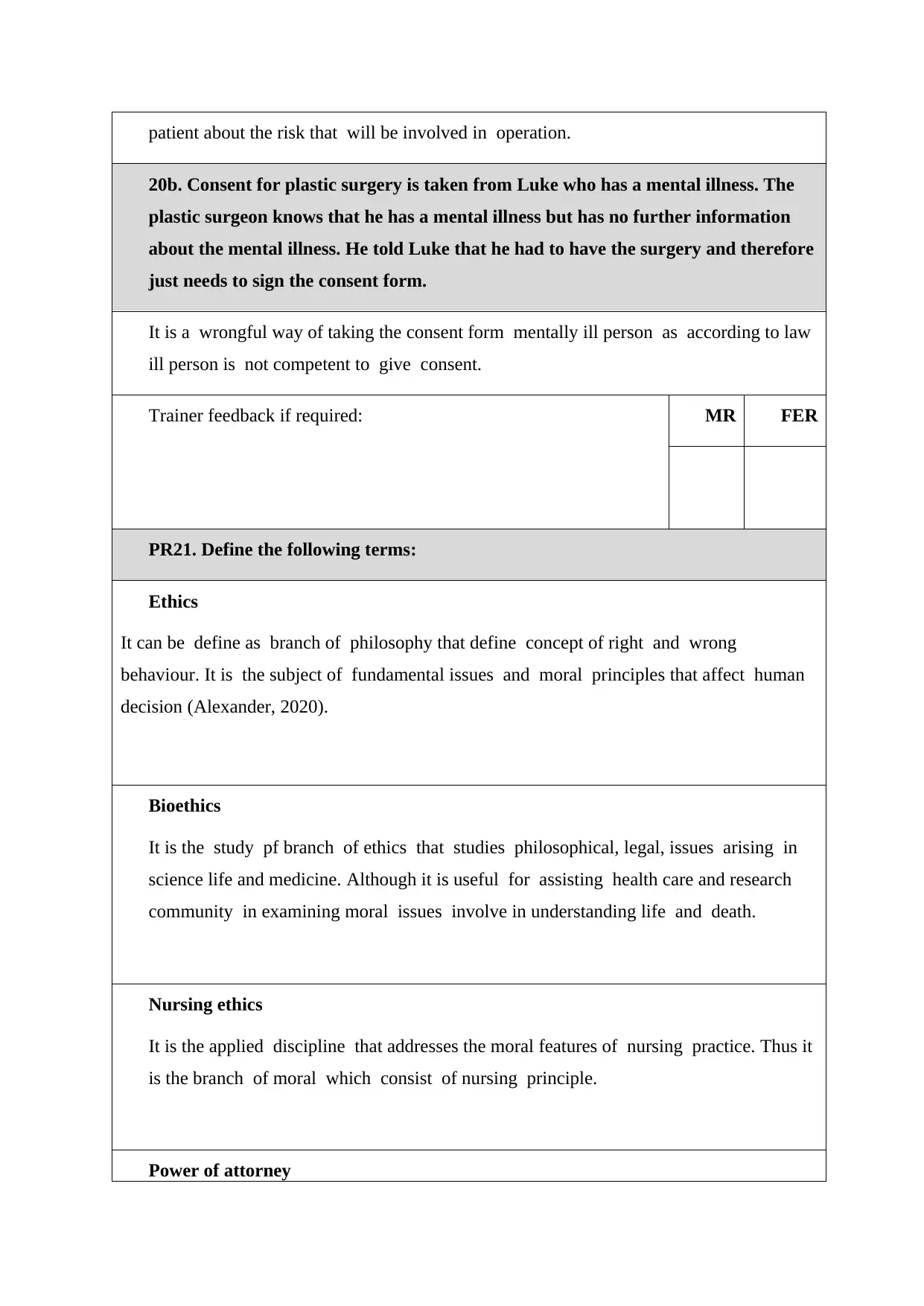
patient about the risk that will be involved in operation.
20b. Consent for plastic surgery is taken from Luke who has a mental illness. The
plastic surgeon knows that he has a mental illness but has no further information
about the mental illness. He told Luke that he had to have the surgery and therefore
just needs to sign the consent form.
It is a wrongful way of taking the consent form mentally ill person as according to law
ill person is not competent to give consent.
Trainer feedback if required: MR FER
PR21. Define the following terms:
Ethics
It can be define as branch of philosophy that define concept of right and wrong
behaviour. It is the subject of fundamental issues and moral principles that affect human
decision (Alexander, 2020).
Bioethics
It is the study pf branch of ethics that studies philosophical, legal, issues arising in
science life and medicine. Although it is useful for assisting health care and research
community in examining moral issues involve in understanding life and death.
Nursing ethics
It is the applied discipline that addresses the moral features of nursing practice. Thus it
is the branch of moral which consist of nursing principle.
Power of attorney
20b. Consent for plastic surgery is taken from Luke who has a mental illness. The
plastic surgeon knows that he has a mental illness but has no further information
about the mental illness. He told Luke that he had to have the surgery and therefore
just needs to sign the consent form.
It is a wrongful way of taking the consent form mentally ill person as according to law
ill person is not competent to give consent.
Trainer feedback if required: MR FER
PR21. Define the following terms:
Ethics
It can be define as branch of philosophy that define concept of right and wrong
behaviour. It is the subject of fundamental issues and moral principles that affect human
decision (Alexander, 2020).
Bioethics
It is the study pf branch of ethics that studies philosophical, legal, issues arising in
science life and medicine. Although it is useful for assisting health care and research
community in examining moral issues involve in understanding life and death.
Nursing ethics
It is the applied discipline that addresses the moral features of nursing practice. Thus it
is the branch of moral which consist of nursing principle.
Power of attorney
Secure Best Marks with AI Grader
Need help grading? Try our AI Grader for instant feedback on your assignments.
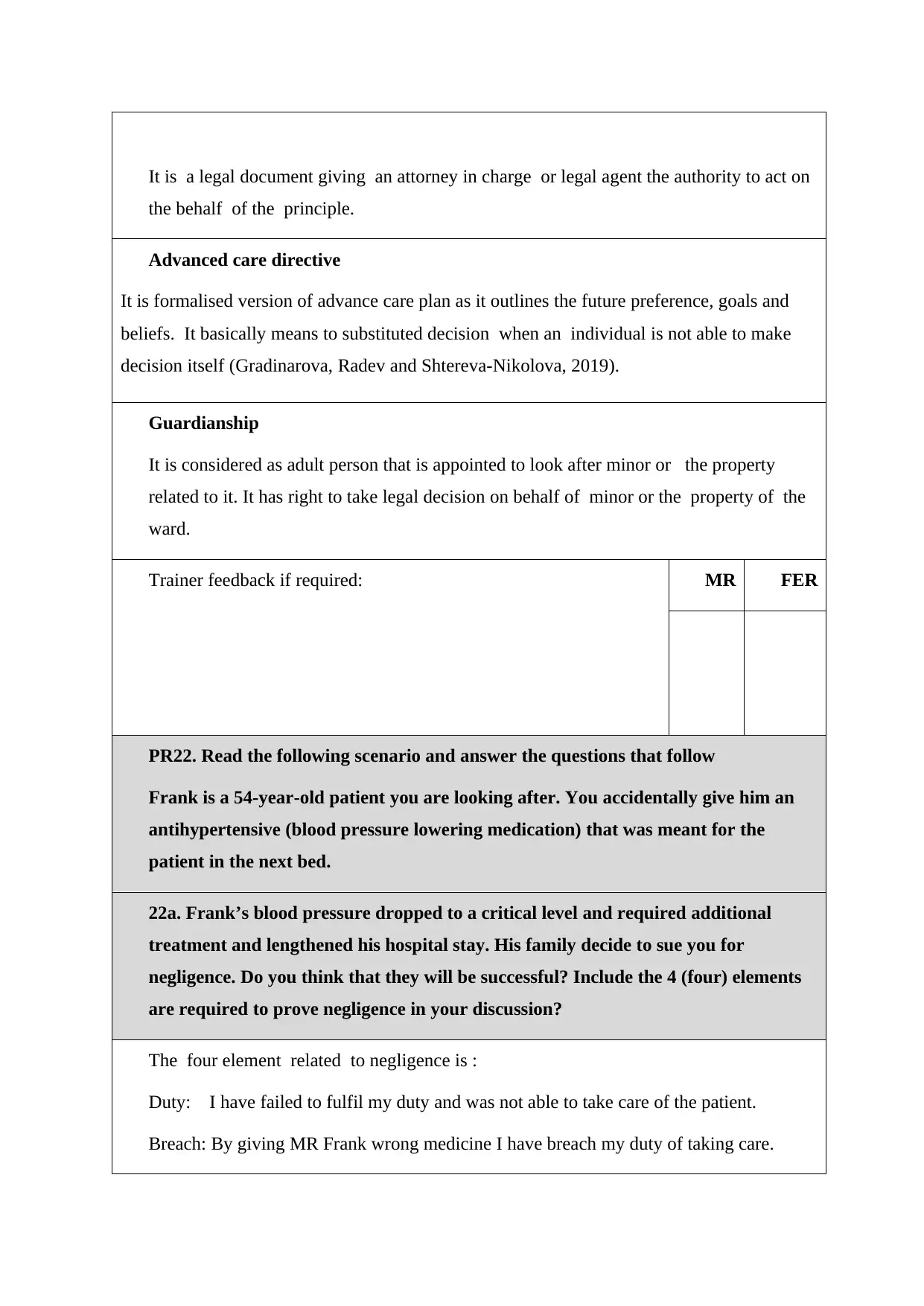
It is a legal document giving an attorney in charge or legal agent the authority to act on
the behalf of the principle.
Advanced care directive
It is formalised version of advance care plan as it outlines the future preference, goals and
beliefs. It basically means to substituted decision when an individual is not able to make
decision itself (Gradinarova, Radev and Shtereva-Nikolova, 2019).
Guardianship
It is considered as adult person that is appointed to look after minor or the property
related to it. It has right to take legal decision on behalf of minor or the property of the
ward.
Trainer feedback if required: MR FER
PR22. Read the following scenario and answer the questions that follow
Frank is a 54-year-old patient you are looking after. You accidentally give him an
antihypertensive (blood pressure lowering medication) that was meant for the
patient in the next bed.
22a. Frank’s blood pressure dropped to a critical level and required additional
treatment and lengthened his hospital stay. His family decide to sue you for
negligence. Do you think that they will be successful? Include the 4 (four) elements
are required to prove negligence in your discussion?
The four element related to negligence is :
Duty: I have failed to fulfil my duty and was not able to take care of the patient.
Breach: By giving MR Frank wrong medicine I have breach my duty of taking care.
the behalf of the principle.
Advanced care directive
It is formalised version of advance care plan as it outlines the future preference, goals and
beliefs. It basically means to substituted decision when an individual is not able to make
decision itself (Gradinarova, Radev and Shtereva-Nikolova, 2019).
Guardianship
It is considered as adult person that is appointed to look after minor or the property
related to it. It has right to take legal decision on behalf of minor or the property of the
ward.
Trainer feedback if required: MR FER
PR22. Read the following scenario and answer the questions that follow
Frank is a 54-year-old patient you are looking after. You accidentally give him an
antihypertensive (blood pressure lowering medication) that was meant for the
patient in the next bed.
22a. Frank’s blood pressure dropped to a critical level and required additional
treatment and lengthened his hospital stay. His family decide to sue you for
negligence. Do you think that they will be successful? Include the 4 (four) elements
are required to prove negligence in your discussion?
The four element related to negligence is :
Duty: I have failed to fulfil my duty and was not able to take care of the patient.
Breach: By giving MR Frank wrong medicine I have breach my duty of taking care.
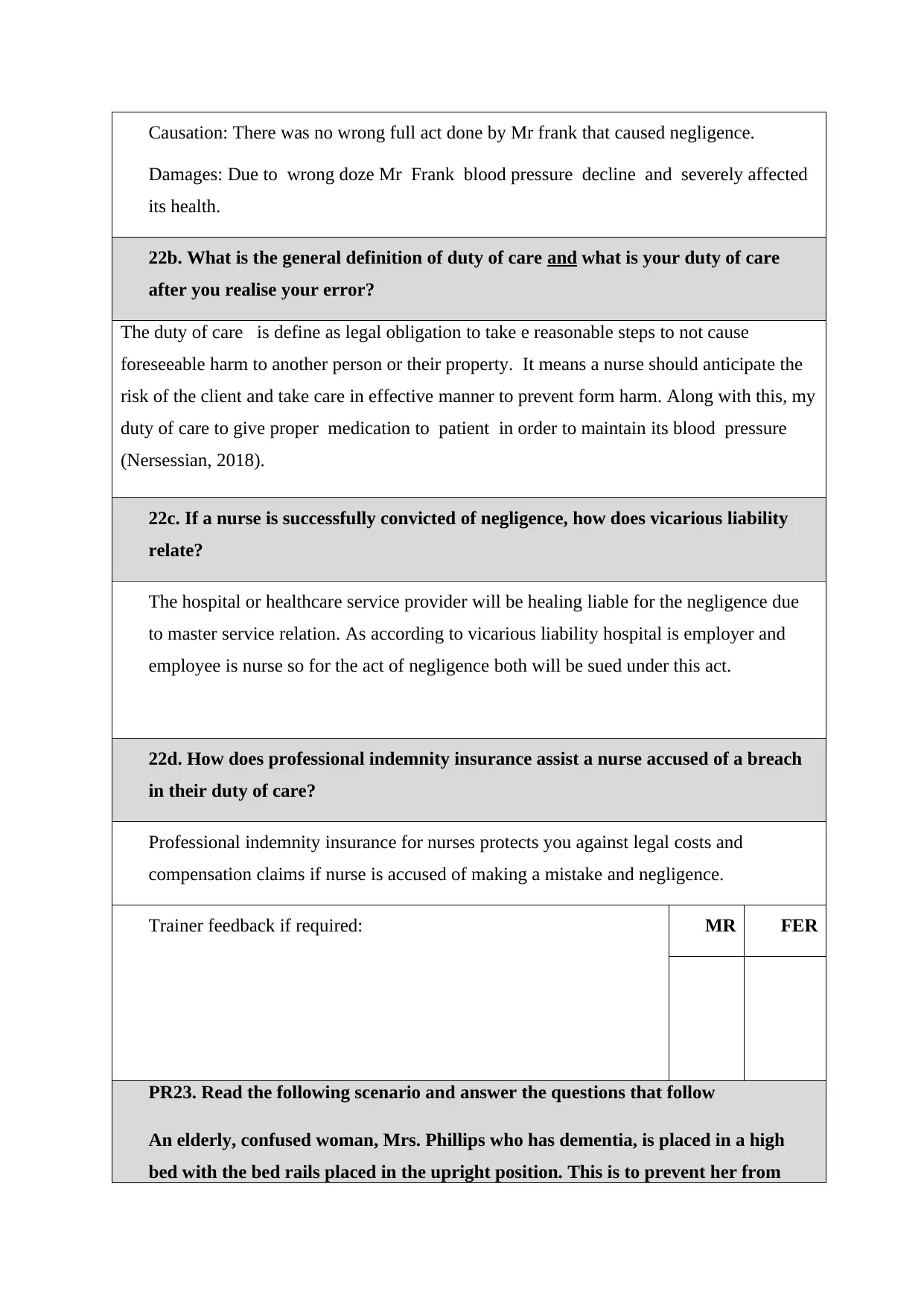
Causation: There was no wrong full act done by Mr frank that caused negligence.
Damages: Due to wrong doze Mr Frank blood pressure decline and severely affected
its health.
22b. What is the general definition of duty of care and what is your duty of care
after you realise your error?
The duty of care is define as legal obligation to take e reasonable steps to not cause
foreseeable harm to another person or their property. It means a nurse should anticipate the
risk of the client and take care in effective manner to prevent form harm. Along with this, my
duty of care to give proper medication to patient in order to maintain its blood pressure
(Nersessian, 2018).
22c. If a nurse is successfully convicted of negligence, how does vicarious liability
relate?
The hospital or healthcare service provider will be healing liable for the negligence due
to master service relation. As according to vicarious liability hospital is employer and
employee is nurse so for the act of negligence both will be sued under this act.
22d. How does professional indemnity insurance assist a nurse accused of a breach
in their duty of care?
Professional indemnity insurance for nurses protects you against legal costs and
compensation claims if nurse is accused of making a mistake and negligence.
Trainer feedback if required: MR FER
PR23. Read the following scenario and answer the questions that follow
An elderly, confused woman, Mrs. Phillips who has dementia, is placed in a high
bed with the bed rails placed in the upright position. This is to prevent her from
Damages: Due to wrong doze Mr Frank blood pressure decline and severely affected
its health.
22b. What is the general definition of duty of care and what is your duty of care
after you realise your error?
The duty of care is define as legal obligation to take e reasonable steps to not cause
foreseeable harm to another person or their property. It means a nurse should anticipate the
risk of the client and take care in effective manner to prevent form harm. Along with this, my
duty of care to give proper medication to patient in order to maintain its blood pressure
(Nersessian, 2018).
22c. If a nurse is successfully convicted of negligence, how does vicarious liability
relate?
The hospital or healthcare service provider will be healing liable for the negligence due
to master service relation. As according to vicarious liability hospital is employer and
employee is nurse so for the act of negligence both will be sued under this act.
22d. How does professional indemnity insurance assist a nurse accused of a breach
in their duty of care?
Professional indemnity insurance for nurses protects you against legal costs and
compensation claims if nurse is accused of making a mistake and negligence.
Trainer feedback if required: MR FER
PR23. Read the following scenario and answer the questions that follow
An elderly, confused woman, Mrs. Phillips who has dementia, is placed in a high
bed with the bed rails placed in the upright position. This is to prevent her from
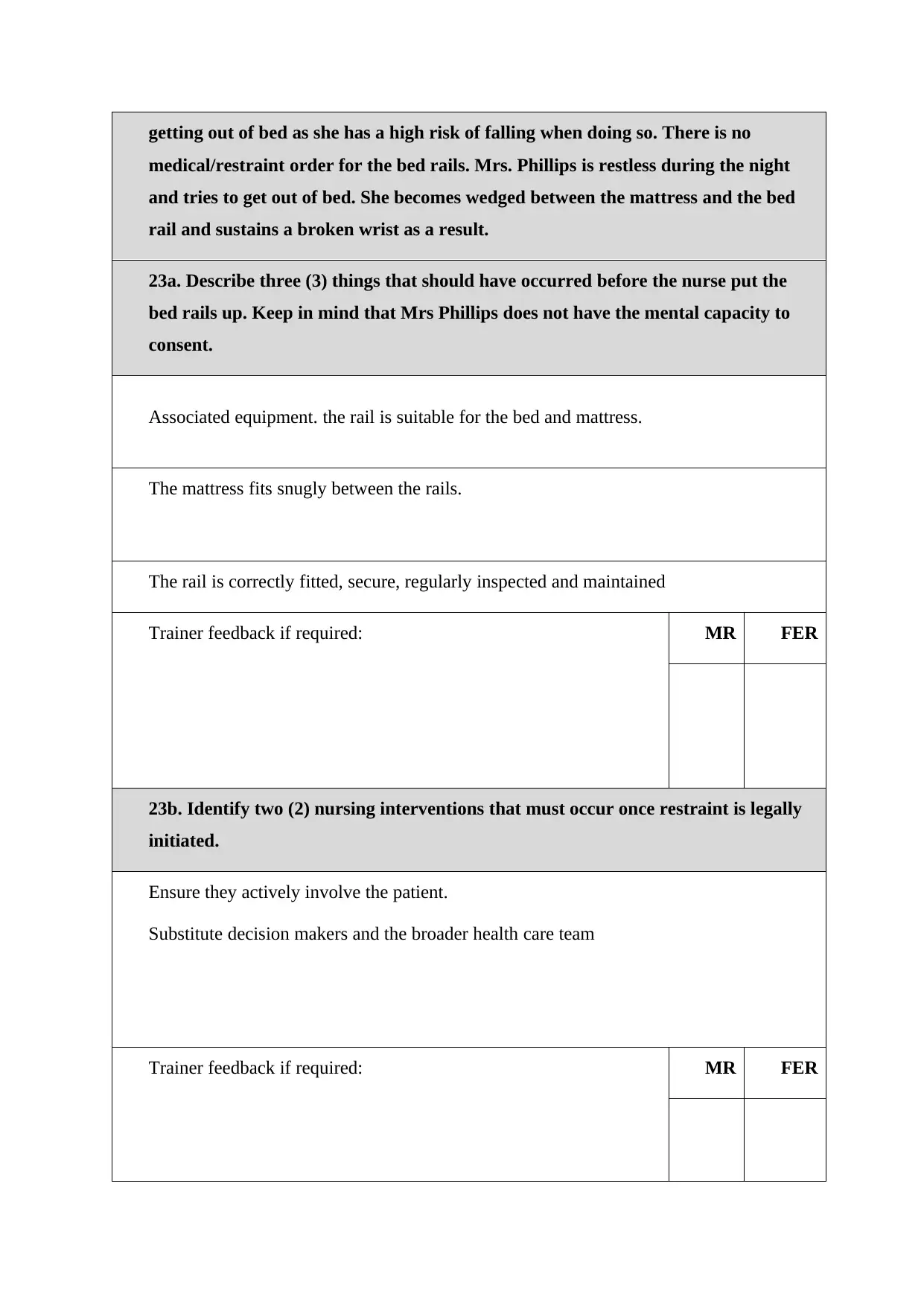
getting out of bed as she has a high risk of falling when doing so. There is no
medical/restraint order for the bed rails. Mrs. Phillips is restless during the night
and tries to get out of bed. She becomes wedged between the mattress and the bed
rail and sustains a broken wrist as a result.
23a. Describe three (3) things that should have occurred before the nurse put the
bed rails up. Keep in mind that Mrs Phillips does not have the mental capacity to
consent.
Associated equipment. the rail is suitable for the bed and mattress.
The mattress fits snugly between the rails.
The rail is correctly fitted, secure, regularly inspected and maintained
Trainer feedback if required: MR FER
23b. Identify two (2) nursing interventions that must occur once restraint is legally
initiated.
Ensure they actively involve the patient.
Substitute decision makers and the broader health care team
Trainer feedback if required: MR FER
medical/restraint order for the bed rails. Mrs. Phillips is restless during the night
and tries to get out of bed. She becomes wedged between the mattress and the bed
rail and sustains a broken wrist as a result.
23a. Describe three (3) things that should have occurred before the nurse put the
bed rails up. Keep in mind that Mrs Phillips does not have the mental capacity to
consent.
Associated equipment. the rail is suitable for the bed and mattress.
The mattress fits snugly between the rails.
The rail is correctly fitted, secure, regularly inspected and maintained
Trainer feedback if required: MR FER
23b. Identify two (2) nursing interventions that must occur once restraint is legally
initiated.
Ensure they actively involve the patient.
Substitute decision makers and the broader health care team
Trainer feedback if required: MR FER
Paraphrase This Document
Need a fresh take? Get an instant paraphrase of this document with our AI Paraphraser
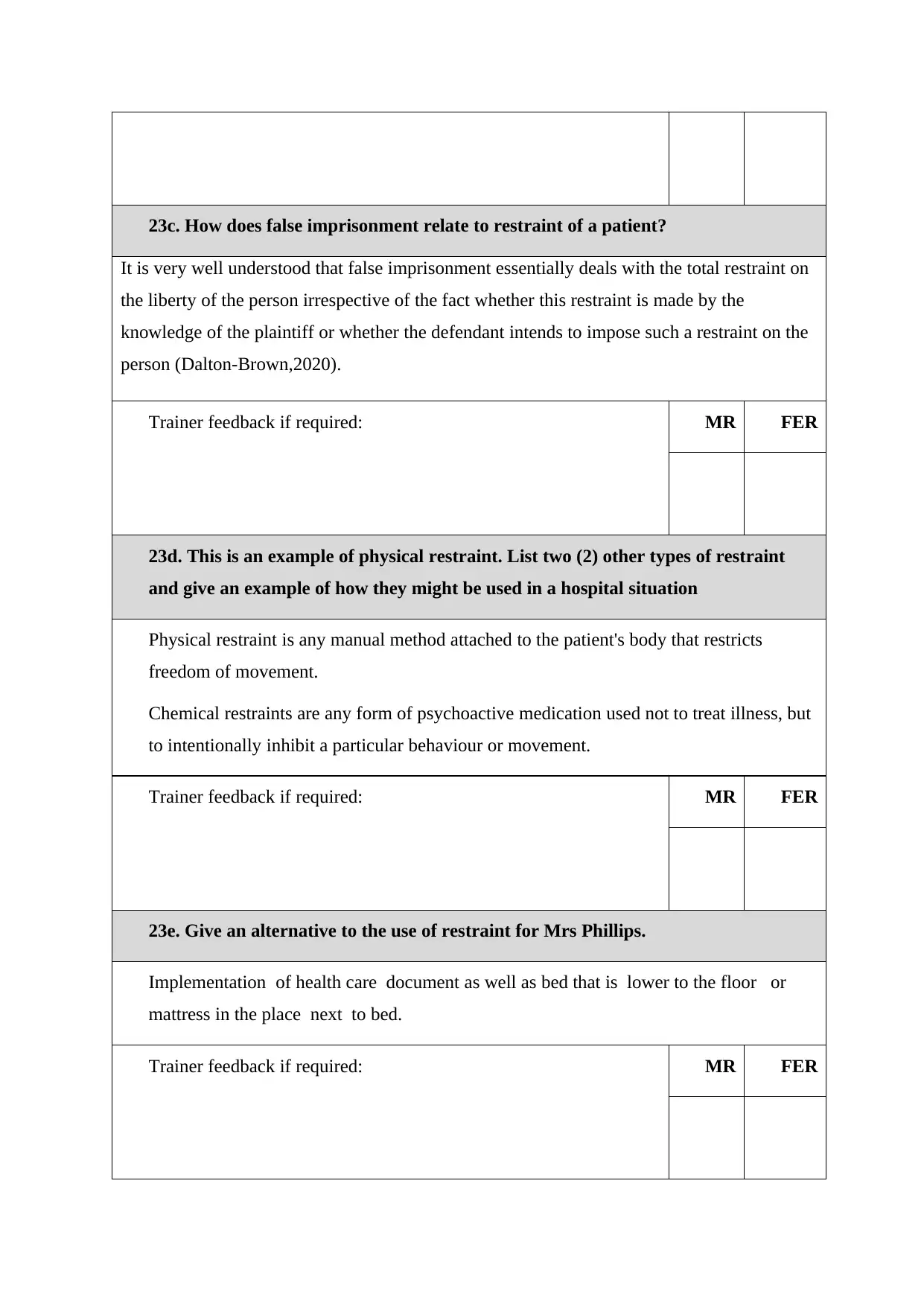
23c. How does false imprisonment relate to restraint of a patient?
It is very well understood that false imprisonment essentially deals with the total restraint on
the liberty of the person irrespective of the fact whether this restraint is made by the
knowledge of the plaintiff or whether the defendant intends to impose such a restraint on the
person (Dalton-Brown,2020).
Trainer feedback if required: MR FER
23d. This is an example of physical restraint. List two (2) other types of restraint
and give an example of how they might be used in a hospital situation
Physical restraint is any manual method attached to the patient's body that restricts
freedom of movement.
Chemical restraints are any form of psychoactive medication used not to treat illness, but
to intentionally inhibit a particular behaviour or movement.
Trainer feedback if required: MR FER
23e. Give an alternative to the use of restraint for Mrs Phillips.
Implementation of health care document as well as bed that is lower to the floor or
mattress in the place next to bed.
Trainer feedback if required: MR FER
It is very well understood that false imprisonment essentially deals with the total restraint on
the liberty of the person irrespective of the fact whether this restraint is made by the
knowledge of the plaintiff or whether the defendant intends to impose such a restraint on the
person (Dalton-Brown,2020).
Trainer feedback if required: MR FER
23d. This is an example of physical restraint. List two (2) other types of restraint
and give an example of how they might be used in a hospital situation
Physical restraint is any manual method attached to the patient's body that restricts
freedom of movement.
Chemical restraints are any form of psychoactive medication used not to treat illness, but
to intentionally inhibit a particular behaviour or movement.
Trainer feedback if required: MR FER
23e. Give an alternative to the use of restraint for Mrs Phillips.
Implementation of health care document as well as bed that is lower to the floor or
mattress in the place next to bed.
Trainer feedback if required: MR FER
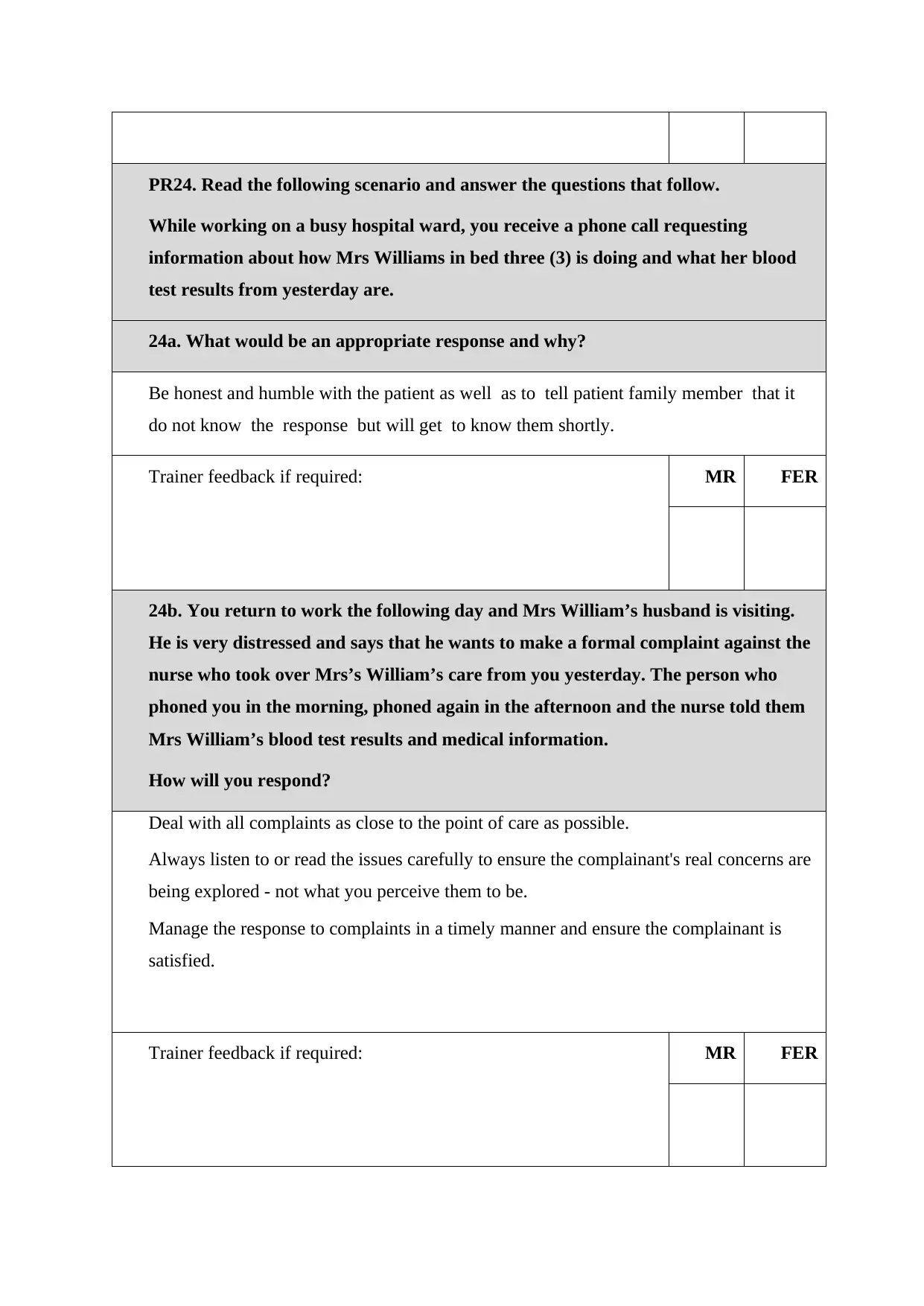
PR24. Read the following scenario and answer the questions that follow.
While working on a busy hospital ward, you receive a phone call requesting
information about how Mrs Williams in bed three (3) is doing and what her blood
test results from yesterday are.
24a. What would be an appropriate response and why?
Be honest and humble with the patient as well as to tell patient family member that it
do not know the response but will get to know them shortly.
Trainer feedback if required: MR FER
24b. You return to work the following day and Mrs William’s husband is visiting.
He is very distressed and says that he wants to make a formal complaint against the
nurse who took over Mrs’s William’s care from you yesterday. The person who
phoned you in the morning, phoned again in the afternoon and the nurse told them
Mrs William’s blood test results and medical information.
How will you respond?
Deal with all complaints as close to the point of care as possible.
Always listen to or read the issues carefully to ensure the complainant's real concerns are
being explored - not what you perceive them to be.
Manage the response to complaints in a timely manner and ensure the complainant is
satisfied.
Trainer feedback if required: MR FER
While working on a busy hospital ward, you receive a phone call requesting
information about how Mrs Williams in bed three (3) is doing and what her blood
test results from yesterday are.
24a. What would be an appropriate response and why?
Be honest and humble with the patient as well as to tell patient family member that it
do not know the response but will get to know them shortly.
Trainer feedback if required: MR FER
24b. You return to work the following day and Mrs William’s husband is visiting.
He is very distressed and says that he wants to make a formal complaint against the
nurse who took over Mrs’s William’s care from you yesterday. The person who
phoned you in the morning, phoned again in the afternoon and the nurse told them
Mrs William’s blood test results and medical information.
How will you respond?
Deal with all complaints as close to the point of care as possible.
Always listen to or read the issues carefully to ensure the complainant's real concerns are
being explored - not what you perceive them to be.
Manage the response to complaints in a timely manner and ensure the complainant is
satisfied.
Trainer feedback if required: MR FER
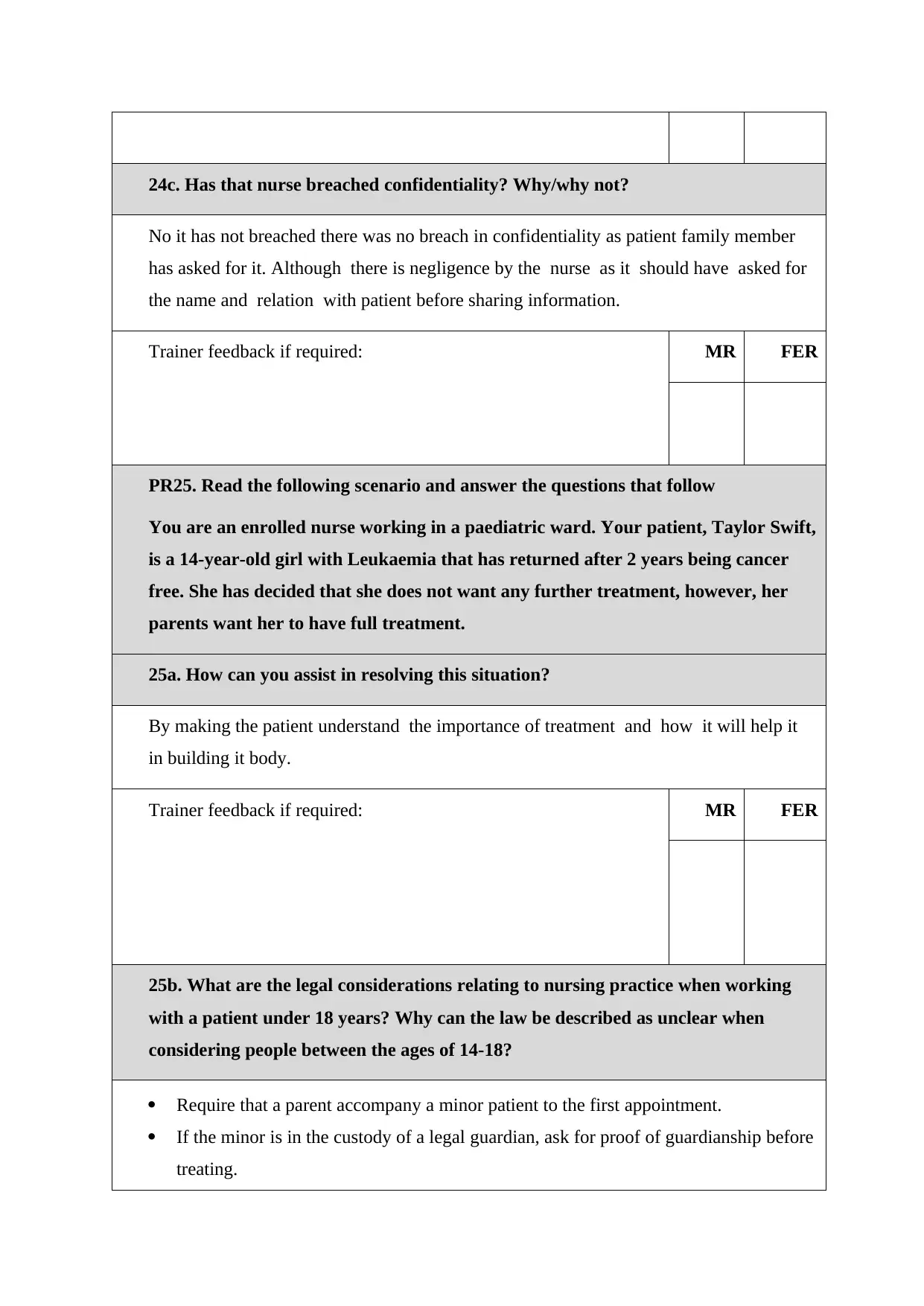
24c. Has that nurse breached confidentiality? Why/why not?
No it has not breached there was no breach in confidentiality as patient family member
has asked for it. Although there is negligence by the nurse as it should have asked for
the name and relation with patient before sharing information.
Trainer feedback if required: MR FER
PR25. Read the following scenario and answer the questions that follow
You are an enrolled nurse working in a paediatric ward. Your patient, Taylor Swift,
is a 14-year-old girl with Leukaemia that has returned after 2 years being cancer
free. She has decided that she does not want any further treatment, however, her
parents want her to have full treatment.
25a. How can you assist in resolving this situation?
By making the patient understand the importance of treatment and how it will help it
in building it body.
Trainer feedback if required: MR FER
25b. What are the legal considerations relating to nursing practice when working
with a patient under 18 years? Why can the law be described as unclear when
considering people between the ages of 14-18?
Require that a parent accompany a minor patient to the first appointment.
If the minor is in the custody of a legal guardian, ask for proof of guardianship before
treating.
No it has not breached there was no breach in confidentiality as patient family member
has asked for it. Although there is negligence by the nurse as it should have asked for
the name and relation with patient before sharing information.
Trainer feedback if required: MR FER
PR25. Read the following scenario and answer the questions that follow
You are an enrolled nurse working in a paediatric ward. Your patient, Taylor Swift,
is a 14-year-old girl with Leukaemia that has returned after 2 years being cancer
free. She has decided that she does not want any further treatment, however, her
parents want her to have full treatment.
25a. How can you assist in resolving this situation?
By making the patient understand the importance of treatment and how it will help it
in building it body.
Trainer feedback if required: MR FER
25b. What are the legal considerations relating to nursing practice when working
with a patient under 18 years? Why can the law be described as unclear when
considering people between the ages of 14-18?
Require that a parent accompany a minor patient to the first appointment.
If the minor is in the custody of a legal guardian, ask for proof of guardianship before
treating.
Secure Best Marks with AI Grader
Need help grading? Try our AI Grader for instant feedback on your assignments.
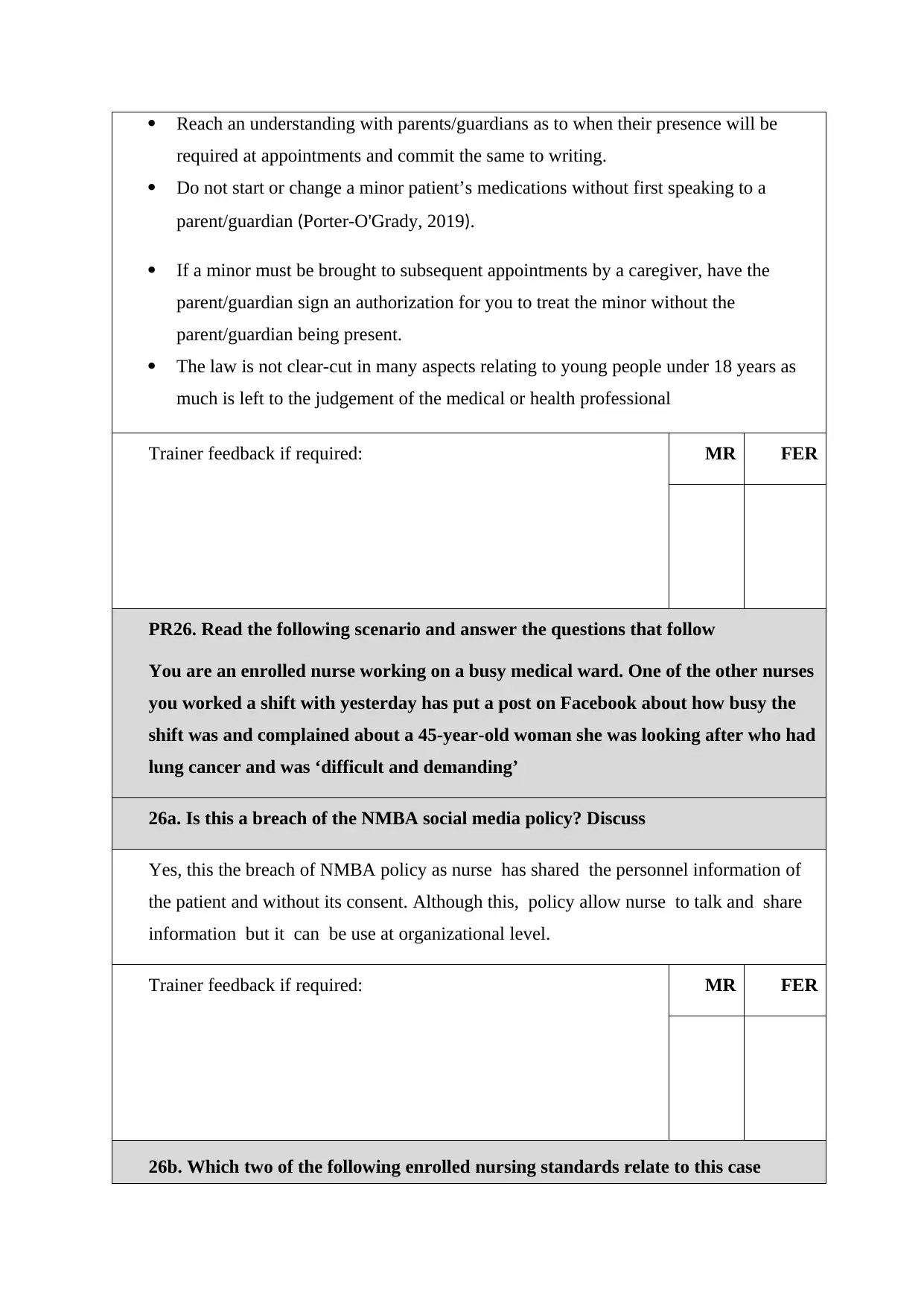
Reach an understanding with parents/guardians as to when their presence will be
required at appointments and commit the same to writing.
Do not start or change a minor patient’s medications without first speaking to a
parent/guardian (Porter-O'Grady, 2019).
If a minor must be brought to subsequent appointments by a caregiver, have the
parent/guardian sign an authorization for you to treat the minor without the
parent/guardian being present.
The law is not clear-cut in many aspects relating to young people under 18 years as
much is left to the judgement of the medical or health professional
Trainer feedback if required: MR FER
PR26. Read the following scenario and answer the questions that follow
You are an enrolled nurse working on a busy medical ward. One of the other nurses
you worked a shift with yesterday has put a post on Facebook about how busy the
shift was and complained about a 45-year-old woman she was looking after who had
lung cancer and was ‘difficult and demanding’
26a. Is this a breach of the NMBA social media policy? Discuss
Yes, this the breach of NMBA policy as nurse has shared the personnel information of
the patient and without its consent. Although this, policy allow nurse to talk and share
information but it can be use at organizational level.
Trainer feedback if required: MR FER
26b. Which two of the following enrolled nursing standards relate to this case
required at appointments and commit the same to writing.
Do not start or change a minor patient’s medications without first speaking to a
parent/guardian (Porter-O'Grady, 2019).
If a minor must be brought to subsequent appointments by a caregiver, have the
parent/guardian sign an authorization for you to treat the minor without the
parent/guardian being present.
The law is not clear-cut in many aspects relating to young people under 18 years as
much is left to the judgement of the medical or health professional
Trainer feedback if required: MR FER
PR26. Read the following scenario and answer the questions that follow
You are an enrolled nurse working on a busy medical ward. One of the other nurses
you worked a shift with yesterday has put a post on Facebook about how busy the
shift was and complained about a 45-year-old woman she was looking after who had
lung cancer and was ‘difficult and demanding’
26a. Is this a breach of the NMBA social media policy? Discuss
Yes, this the breach of NMBA policy as nurse has shared the personnel information of
the patient and without its consent. Although this, policy allow nurse to talk and share
information but it can be use at organizational level.
Trainer feedback if required: MR FER
26b. Which two of the following enrolled nursing standards relate to this case
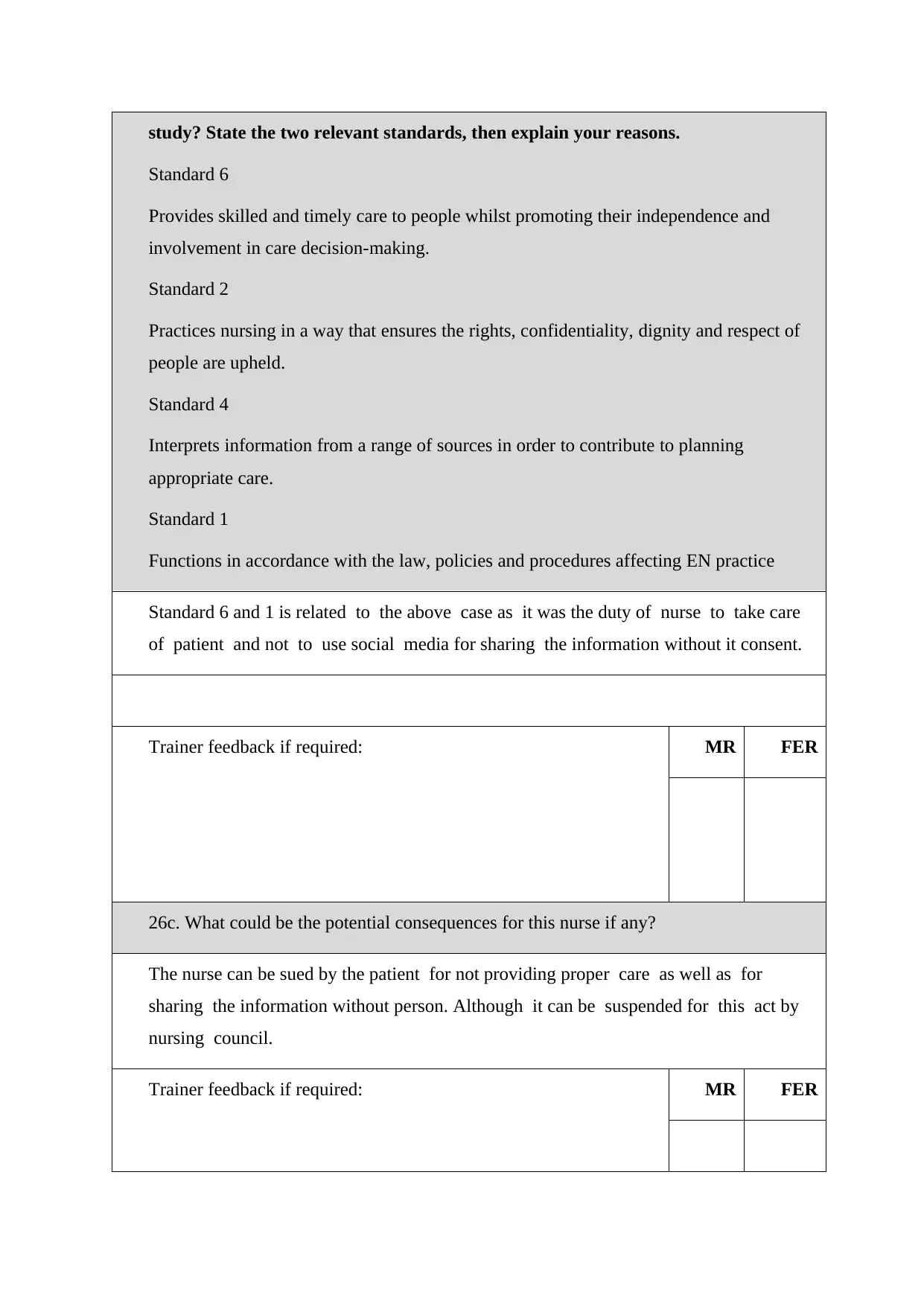
study? State the two relevant standards, then explain your reasons.
Standard 6
Provides skilled and timely care to people whilst promoting their independence and
involvement in care decision-making.
Standard 2
Practices nursing in a way that ensures the rights, confidentiality, dignity and respect of
people are upheld.
Standard 4
Interprets information from a range of sources in order to contribute to planning
appropriate care.
Standard 1
Functions in accordance with the law, policies and procedures affecting EN practice
Standard 6 and 1 is related to the above case as it was the duty of nurse to take care
of patient and not to use social media for sharing the information without it consent.
Trainer feedback if required: MR FER
26c. What could be the potential consequences for this nurse if any?
The nurse can be sued by the patient for not providing proper care as well as for
sharing the information without person. Although it can be suspended for this act by
nursing council.
Trainer feedback if required: MR FER
Standard 6
Provides skilled and timely care to people whilst promoting their independence and
involvement in care decision-making.
Standard 2
Practices nursing in a way that ensures the rights, confidentiality, dignity and respect of
people are upheld.
Standard 4
Interprets information from a range of sources in order to contribute to planning
appropriate care.
Standard 1
Functions in accordance with the law, policies and procedures affecting EN practice
Standard 6 and 1 is related to the above case as it was the duty of nurse to take care
of patient and not to use social media for sharing the information without it consent.
Trainer feedback if required: MR FER
26c. What could be the potential consequences for this nurse if any?
The nurse can be sued by the patient for not providing proper care as well as for
sharing the information without person. Although it can be suspended for this act by
nursing council.
Trainer feedback if required: MR FER
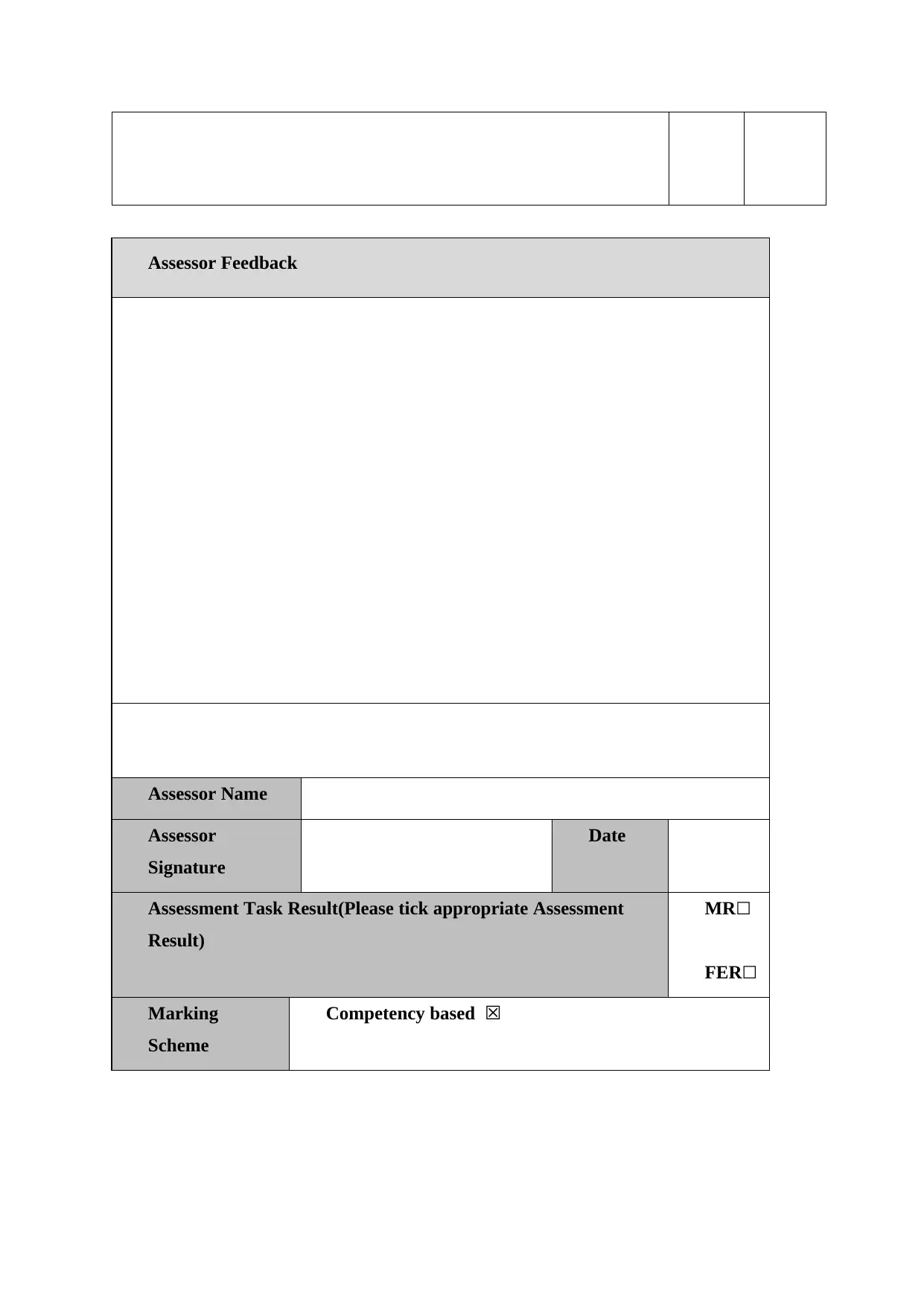
Assessor Feedback
Assessor Name
Assessor
Signature
Date
Assessment Task Result(Please tick appropriate Assessment
Result)
MR☐
FER☐
Marking
Scheme
Competency based ☒
Assessor Name
Assessor
Signature
Date
Assessment Task Result(Please tick appropriate Assessment
Result)
MR☐
FER☐
Marking
Scheme
Competency based ☒
Paraphrase This Document
Need a fresh take? Get an instant paraphrase of this document with our AI Paraphraser
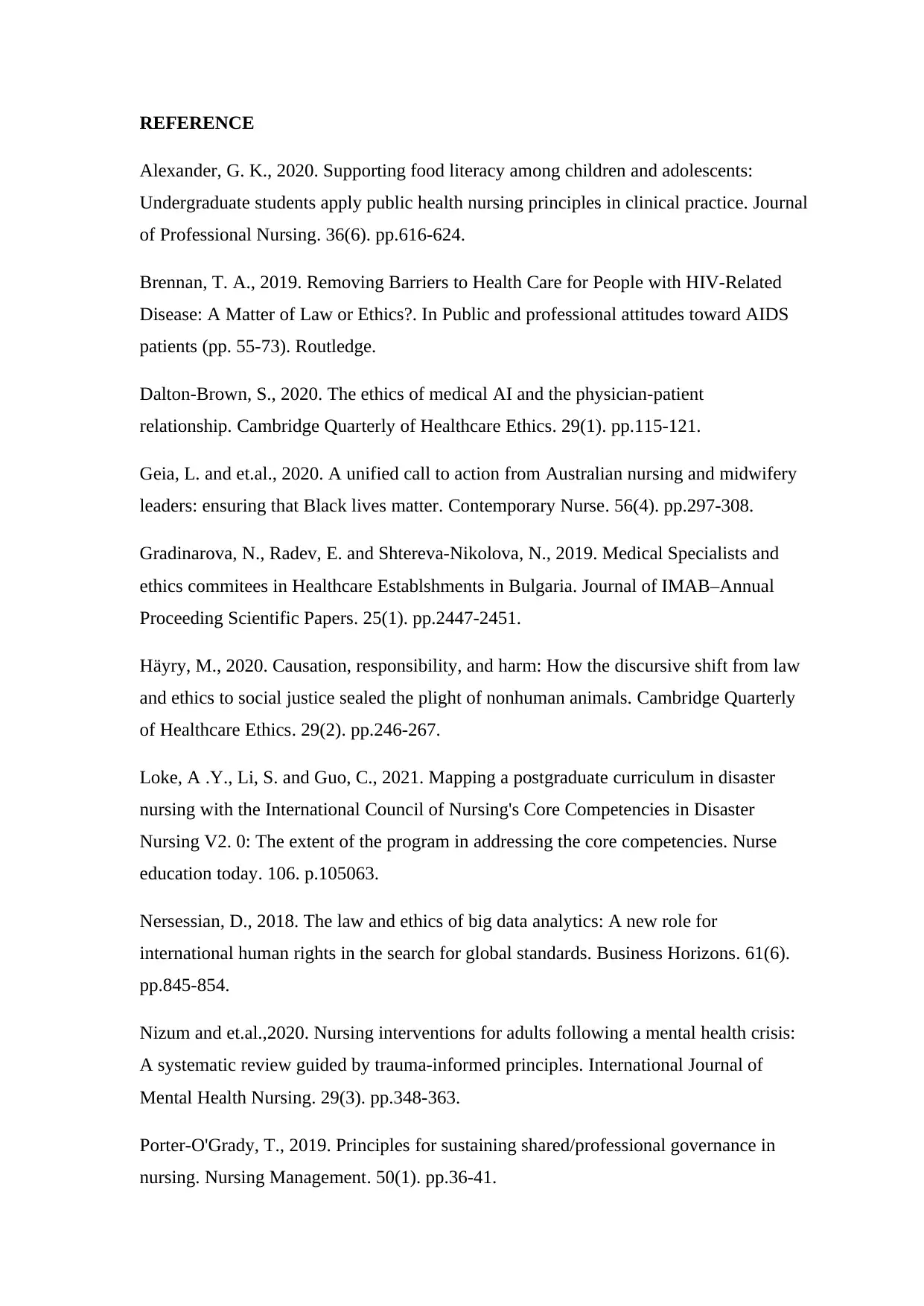
REFERENCE
Alexander, G. K., 2020. Supporting food literacy among children and adolescents:
Undergraduate students apply public health nursing principles in clinical practice. Journal
of Professional Nursing. 36(6). pp.616-624.
Brennan, T. A., 2019. Removing Barriers to Health Care for People with HIV-Related
Disease: A Matter of Law or Ethics?. In Public and professional attitudes toward AIDS
patients (pp. 55-73). Routledge.
Dalton-Brown, S., 2020. The ethics of medical AI and the physician-patient
relationship. Cambridge Quarterly of Healthcare Ethics. 29(1). pp.115-121.
Geia, L. and et.al., 2020. A unified call to action from Australian nursing and midwifery
leaders: ensuring that Black lives matter. Contemporary Nurse. 56(4). pp.297-308.
Gradinarova, N., Radev, E. and Shtereva-Nikolova, N., 2019. Medical Specialists and
ethics commitees in Healthcare Establshments in Bulgaria. Journal of IMAB–Annual
Proceeding Scientific Papers. 25(1). pp.2447-2451.
Häyry, M., 2020. Causation, responsibility, and harm: How the discursive shift from law
and ethics to social justice sealed the plight of nonhuman animals. Cambridge Quarterly
of Healthcare Ethics. 29(2). pp.246-267.
Loke, A .Y., Li, S. and Guo, C., 2021. Mapping a postgraduate curriculum in disaster
nursing with the International Council of Nursing's Core Competencies in Disaster
Nursing V2. 0: The extent of the program in addressing the core competencies. Nurse
education today. 106. p.105063.
Nersessian, D., 2018. The law and ethics of big data analytics: A new role for
international human rights in the search for global standards. Business Horizons. 61(6).
pp.845-854.
Nizum and et.al.,2020. Nursing interventions for adults following a mental health crisis:
A systematic review guided by trauma‐informed principles. International Journal of
Mental Health Nursing. 29(3). pp.348-363.
Porter-O'Grady, T., 2019. Principles for sustaining shared/professional governance in
nursing. Nursing Management. 50(1). pp.36-41.
Alexander, G. K., 2020. Supporting food literacy among children and adolescents:
Undergraduate students apply public health nursing principles in clinical practice. Journal
of Professional Nursing. 36(6). pp.616-624.
Brennan, T. A., 2019. Removing Barriers to Health Care for People with HIV-Related
Disease: A Matter of Law or Ethics?. In Public and professional attitudes toward AIDS
patients (pp. 55-73). Routledge.
Dalton-Brown, S., 2020. The ethics of medical AI and the physician-patient
relationship. Cambridge Quarterly of Healthcare Ethics. 29(1). pp.115-121.
Geia, L. and et.al., 2020. A unified call to action from Australian nursing and midwifery
leaders: ensuring that Black lives matter. Contemporary Nurse. 56(4). pp.297-308.
Gradinarova, N., Radev, E. and Shtereva-Nikolova, N., 2019. Medical Specialists and
ethics commitees in Healthcare Establshments in Bulgaria. Journal of IMAB–Annual
Proceeding Scientific Papers. 25(1). pp.2447-2451.
Häyry, M., 2020. Causation, responsibility, and harm: How the discursive shift from law
and ethics to social justice sealed the plight of nonhuman animals. Cambridge Quarterly
of Healthcare Ethics. 29(2). pp.246-267.
Loke, A .Y., Li, S. and Guo, C., 2021. Mapping a postgraduate curriculum in disaster
nursing with the International Council of Nursing's Core Competencies in Disaster
Nursing V2. 0: The extent of the program in addressing the core competencies. Nurse
education today. 106. p.105063.
Nersessian, D., 2018. The law and ethics of big data analytics: A new role for
international human rights in the search for global standards. Business Horizons. 61(6).
pp.845-854.
Nizum and et.al.,2020. Nursing interventions for adults following a mental health crisis:
A systematic review guided by trauma‐informed principles. International Journal of
Mental Health Nursing. 29(3). pp.348-363.
Porter-O'Grady, T., 2019. Principles for sustaining shared/professional governance in
nursing. Nursing Management. 50(1). pp.36-41.
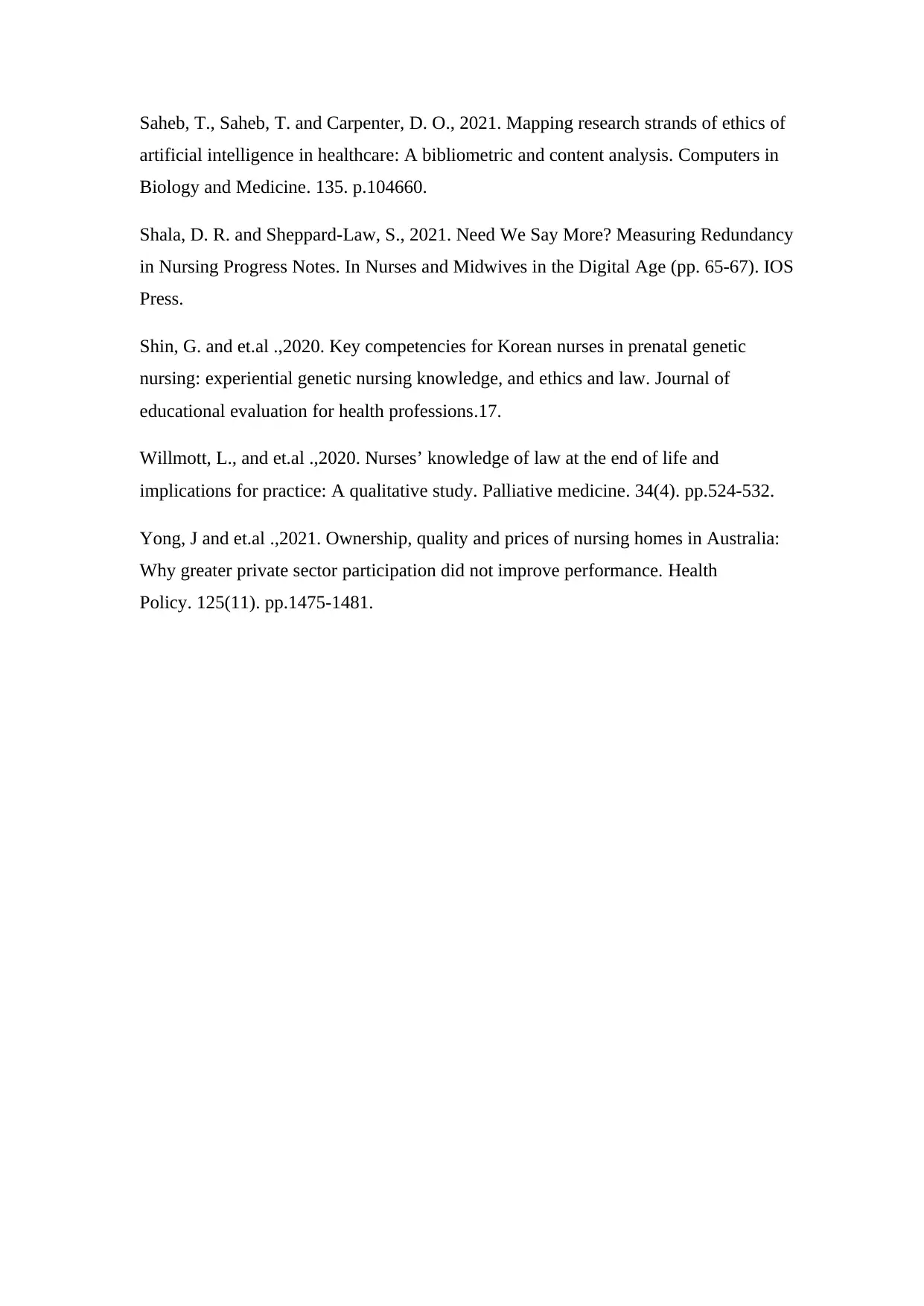
Saheb, T., Saheb, T. and Carpenter, D. O., 2021. Mapping research strands of ethics of
artificial intelligence in healthcare: A bibliometric and content analysis. Computers in
Biology and Medicine. 135. p.104660.
Shala, D. R. and Sheppard-Law, S., 2021. Need We Say More? Measuring Redundancy
in Nursing Progress Notes. In Nurses and Midwives in the Digital Age (pp. 65-67). IOS
Press.
Shin, G. and et.al .,2020. Key competencies for Korean nurses in prenatal genetic
nursing: experiential genetic nursing knowledge, and ethics and law. Journal of
educational evaluation for health professions.17.
Willmott, L., and et.al .,2020. Nurses’ knowledge of law at the end of life and
implications for practice: A qualitative study. Palliative medicine. 34(4). pp.524-532.
Yong, J and et.al .,2021. Ownership, quality and prices of nursing homes in Australia:
Why greater private sector participation did not improve performance. Health
Policy. 125(11). pp.1475-1481.
artificial intelligence in healthcare: A bibliometric and content analysis. Computers in
Biology and Medicine. 135. p.104660.
Shala, D. R. and Sheppard-Law, S., 2021. Need We Say More? Measuring Redundancy
in Nursing Progress Notes. In Nurses and Midwives in the Digital Age (pp. 65-67). IOS
Press.
Shin, G. and et.al .,2020. Key competencies for Korean nurses in prenatal genetic
nursing: experiential genetic nursing knowledge, and ethics and law. Journal of
educational evaluation for health professions.17.
Willmott, L., and et.al .,2020. Nurses’ knowledge of law at the end of life and
implications for practice: A qualitative study. Palliative medicine. 34(4). pp.524-532.
Yong, J and et.al .,2021. Ownership, quality and prices of nursing homes in Australia:
Why greater private sector participation did not improve performance. Health
Policy. 125(11). pp.1475-1481.
1 out of 27
Related Documents
Your All-in-One AI-Powered Toolkit for Academic Success.
+13062052269
info@desklib.com
Available 24*7 on WhatsApp / Email
![[object Object]](/_next/static/media/star-bottom.7253800d.svg)
Unlock your academic potential
© 2024 | Zucol Services PVT LTD | All rights reserved.



